
This year INK celebrates its tenth birthday, and it is once again a wonderful celebration of the students’ academic work. Whether its marriage, monarchy or the multiverse, spiders or Shakespeare, there is something for everyone within these pages. This magazine would not exist without the hard work of the students, and the support of staff in encouraging their efforts, and to them I offer my sincere thanks.
Joel Ireland has two submissions, the first of which won him a certificate of Special Commendation in the Cambridge Centre for Animal Rights Law essay competition. His entry won £250 for the school, which has been spent on books to help students with their applications to law degrees in the future.
And if after reading the articles you need some time to pause and reflect, perhaps you could do so while enjoying Millie Virtue’s exquisite still life on the front cover.

3-4
5-7
If there is no essential difference between human and other animals, how does this affect the arguments for and against animal rights laws?
Discussion of Act 3 Scene 1 of Hamlet, exploring Shakespeare’s use of language and its dramatic effects
8-9 Should we allow political donations?
10 Murder and the media
Joel Ireland
Julia Nicholls
Adam Smith
Daisy Holroyd
11 Izzy Jupe Izzy Jupe
16-20 An Analysis of the Representation of Conflict in Modern Art
21-22 The Red String
23-25
How likely is the multiverse? Would it change anything if (somehow) we came to know the theory was true?
Georgia Humberstone
Beth Roberts
James Restell
26-28 The First World War and The Decline of a Collective European Culture Freddie Dodson
29-33
What methods do artists use to capture movement in their work and what does it add to it? Josh Rowley
36 To what extent were Hitler and Stalin similar? Josh Taylor
37 Marriage is an outdated concept
38-39 Are politicians dishonest or can we trust them? Josh Wild
40-42 How have artists used line within sculpture? Natalia Schmitt
43-45 Must we always obey the law?
46 Oh my goodness, I hate spiders
Joel Ireland
Orion O’Connor
What are the environmental costs of current consumer trends, behaviours and purchasing decisions? Tom Dodgson 49 Should the monarchy end when the Queen dies? Ben Dakin
47-48
Evans de Céspedes 51 Shell Shock
Cassidy
William Baker Head of Sixth Form
Cover painting by Millie Virtue: Still life (GCSE)
Rosalind Mitchell
Gabriela
Contents Editorial 2
50 Les glaçons Clara
In Darwin’s Theory of Natural Selection, he proclaims that “There is no fundamental difference between man and the higher mammals in their mental faculties”.

(Humane Decisions, 2016) He also advocates that the difference, if any, between humans and non-human animals (animals hereafter) “is one of degree and not of kind”. If this aforesaid comparison holds merit, then it ought to be our moral obligation and responsibility to provide similar rights to animals as the ones established to protect humans. Numerous animals are akin to humans in their capacity to discern by sense and so providing them with legal instruments for the redress of their grievances is justifiable. However, our supposedly superior metacognitive capacities and human nature might be enough of a reason to explain the current moral distinction held between humans and animals and provide an argument against extending animal rights.
Firstly, we need to address what this essay aims to answer. The question being, is it true that biological similarity holds overriding value on the debate of animal rights law? Is biological similarity an adequate reason to grant rights to animals?
Biological similarity can be defined as common traits shared interspecies due to the genetic composition of such beings. Features such as cognitive ability,
fundamental organismic processes and sentience will be characterised as biological similarities. Sentience is dependent on cognitive abilities and environmental analysis, resulting from complex brain activity and for that reason it is classed as a biological trait (Centre for Animal Welfare and Anthrozoology Department of Veterinary Medicine, University of Cambridge, 2014).
Biological similarity is a sufficient reason to provide animals with the same rights as humans because if they are alike, we should not treat them differently. Chimpanzees are among our closest living relatives, sharing a common ancestor with humans a mere six to eight million years ago. In 1960, Jane Goodall investigated the behavioural characteristics of wild chimpanzees in Tanzania (Jane Goodall Institute UK, 2023). Studies of chimpanzees like Jane’s have revealed several aspects of human evolution, including tool use and other cultural traits such as hunting and intergroup violence (National Library of Medicine, 2017). If justice demands that like beings be treated alike, it cannot be just to exploit biologically similar animals on the grounds that humans themselves are

not subject to such behaviour. If animals possess the characteristics which we use to define humans, then they should be entitled to equivalent protection under the law. This biological similarity argument is what drove numerous other movements including the civil rights movement of the US, which was a campaign by Black Americans to receive equal protection under the law. They advocated against segregation and proclaimed that such treatment should not be permitted in a just, constitutional society. Therefore, because there is no obvious fundamental difference between humans and higher mammals, we are morally obliged to present such animals with matching laws, as that is what a just society must do (Bryant, 2007).
However, biological similarity might be deemed insufficient in the eyes of the law. There are many flaws with this similarity argument. Whilst our closest relatives, chimpanzees, share several essential human characteristics, this statement is not entirely true for all animals. Furthermore, the caveat that animals do not share enough characteristics to receive equal protection under the law holds merit. Whilst a successful study conducted by Daniel J Povinelli in 1997 proved that chimpanzees
If there is no essential difference between human and other animals, how does this affect the arguments for and against animal rights laws?
[T]here is no obvious evidence of animals engaging in mental time travel which is the ability to foresee future scenarios.
Lower Sixth
Joel Ireland
Jane Goodall
3
Charles Darwin an English naturalist, geologist, and biologist, widely known for his contributions to evolutionary biology
exhibited self-awareness traits (Science Direct, 1997), various cognitive abilities which humans display have not yet been demonstrated by animals. For example, there is no obvious evidence of animals engaging in mental time travel which is the ability to foresee future scenarios (Scientific American, 2018). Mental time travel is one of the main reasons why we impose laws in the first place. Because we can see potential future predicaments, we try to prevent these by enacting laws. Aristotle proclaimed that the difference between humans and animals was that humans possessed a “rational soul,” in addition to the “sensitive soul” of animals (The Guardian, 2022). Furthermore, another pitfall of the similarity argument is that it would be impractical to supply rights to animals with the closest biological proximity to humans and not others. Determining whether a certain species exhibits enough similarities to reap the benefit of protection under the law would be injudicious and would create an unmanageable hierarchy in the animal kingdom led by humans. Consequently,
whilst biological similarity has some influence on the debate of animal rights, the similarities might just fall short of equal access to legal protection.

Furthermore, biological similarity must not have such a profound influence on the animal rights debate, since we are already supplying laws protecting animals which are distant from humans. For example, under the Protection of Animals Act of 1911 (The National Archives 2023), it is stated that “If any person cause[s] any unnecessary suffering to any domestic or captive animal [they] shall be liable on summary conviction to imprisonment for a term not exceeding six months or to a fine not exceeding level five on the standard scale”. The act aims to protect any “sufficiently tamed [animal which] serve[s] some purpose for the use of man”. This reveals that rights and laws are issued to animals which possess some use to humans as opposed to being biologically similar.
To conclude, whilst similarity should be sufficient grounds for granting rights to
animals, this advocation itself might not be the problem. The problem might rest in the social construct of society, a common misconception being that animals are not sentient beings and cannot experience suffering and pain. There has been an absence of necessity in petitioning new animal rights laws. It was only recently that the law recognised certain animals as sentient. The Animal Welfare (Sentience) Act 2022 (The National Archives, 2023) is an example which states that any vertebrate other than homo sapiens such as any cephalopod mollusc, and any decapod crustacean will be formally recognised as sentient entities by law as of 2022 (Gov. uk, 2022). Hence, biological similarity is an adequate reason for providing such animals with equal rights. Regrettably though, in the society in which we live, reflective of human nature, if such animals do not bear sufficient value to humans, society will not prioritise or feel the need to provide them with mirrored rights. Moreover, it would create a hierarchical society. Animals which are more closely related to humans would receive more extensive rights than others and it would create a complex unjust system of laws impossible to enforce.
It was only recently that the law recognised certain animals as sentient.
4
The United Kingdom was the first country in the world to implement laws protecting animals as early as 1822
Discussion of Act 3 Scene 1 of Hamlet, exploring Shakespeare’s use of language and its dramatic effects
Julia Nicholls
Lower Sixth
be that Hamlet is actually aware that he is being watched by the king and Polonius and chooses to lie in order to confound Polonius’ doubts about his mad love for Ophelia.

Despite Ophelia’s seemingly natural reticence and her quiet demeanour, she seems to assert herself against Hamlet’s cutting remarks towards the start of the scene. Following Hamlet’s lie that he ‘never gave…aught’, Ophelia replies by saying ‘you know right well you did’, suggesting that she is finally starting to stand up for herself. Similarly, when Ophelia describes how ‘rich gifts wax poor when givers prove unkind’, it seems as if she is retaliating against Hamlet’s contempt and making a dig at his animosity once and for all.
built up in the exchange between Hamlet and Ophelia, making the audience wary of what might happen next.
In this passage, Hamlet and Ophelia find themselves in an increasingly heated exchange whilst being spied upon by King Claudius and Polonius, Ophelia’s father. The overall feeling conveyed by the passage is one of anger and bitterness, making it somewhat painful for the audience to witness. There is also a significant focus on sex, forced mainly by Hamlet, which not only seems inappropriate but also poses the key question of whether or not his supposed madness is actually real.
At the start of the passage, when Hamlet first sees Ophelia on stage, he says ‘soft you now’, telling her to be quiet and to wait a moment. This implies that he is impatient and suggests a certain level of disrespect as he does not even bother to greet her politely.
Likewise, when he says, ‘I humbly thank you, well’, it is presented as sarcastic to the audience and his lack of sincerity is highlighted.
Following Ophelia’s request to ‘redeliver’ the ‘remembrances’ that Hamlet once sent to her, Hamlet replies by saying that ‘no’, he ‘never gave… aught’, which is a lie. This could reflect his potentially hurt pride, since Ophelia has refused his gifts to her under her father’s orders and so he could be lying simply to protect his ego and conceal his humiliation. However, a different interpretation could
Despite this, Hamlet appears to regain control of the conversation as he shifts the register from Ophelia’s couplet to prose, allowing him the opportunity to question her more closely through a change into rapid dialogue. His response to her rebuttal seems rather strange, and could make the audience uneasy, as he exclaims ‘Ha! Ha! Are you honest?’ in what could be perceived as an aggressive tone. It signifies not only a change in register, but also a change in the subject of the conversation, as Hamlet suddenly starts analysing Ophelia’s beauty and chastity. Perhaps the reason for this could be a continuation of Hamlet’s hurt pride, along with internal surprise at her assertive replies to his remarks, or contrastingly he could be asking her the question because he knows that they are being spied upon, and thus wishes to aim the question at Polonius, who would be interested in the matter of his daughter’s virginity. Furthermore, this sudden outburst could affirm suspicions of his madness to the onlookers, although ironically the audience knows that this could simply be the antic disposition being acted upon. However, it must be made clear that whether or not Hamlet knows of the espionage in this scene remains an unknown fact to the audience. This uncertainty increases the tension already
Whatever the reason for Hamlet’s eruption, it clearly throws Ophelia off guard as well, as her responses are short and seem to lack the confidence and assertion that she possessed not long ago. This results in stichomythia, in which Ophelia cannot seem to answer Hamlet’s questions for she is too shocked, only managing to utter a simple ‘my lord’ and ‘what means your lordship?’ in reply. Hamlet turns the conversation into a scrutiny of Ophelia’s fairness and honesty, saying ‘that if you be honest and fair you should admit no discourse to your beauty’. Essentially, he is repeating the conventional belief of the Shakespearean time, which is that beauty and chastity are seemingly incompatible and difficult to reconcile. It suggests that beauty is a potential threat to chastity, which in itself portrays the concept of virginity as something sacred and unbreakable. However, in today’s society, we can see how misogynistic this view is, as it limits women’s sexual liberty and independence.
In Ophelia’s response to this personal attack on the matter of her chastity, the audience can see that she attempts to move the focus away from herself by using abstract personifications to take meaning away from the individual and turn it into a philosophical debate. The capitalisation used when Ophelia says, ‘could Beauty, my lord, have better commerce than with Honesty?’ shows how she is personifying these abstract qualities to make them more generalised. However, Hamlet seems to somewhat ignore Ophelia’s attempts to reconcile the conversation, and instead he continues describing ‘the power of Beauty’ to ‘transform Honesty…to a bawd’, showing his cynicism of love and the deep-rooted societal misogyny he adds to, along with imagery of disease and sexual corruption. This discourse is concluded when Hamlet tells Ophelia ‘I did love you once’ in a monosyllabic sentence, implying that his strong cynicism of love has led him to not even know what it means anymore. However, this sentence is short and, particularly when compared to the longwinded points he makes before it, could be
[T]his sudden outburst could affirm suspicions of his madness to the onlookers.
5
interpreted as the only candid thing Hamlet has said to Ophelia so far, suggesting a certain vulnerability in love, and bringing the philosophical element back round to a more personal sentiment once again.
Nevertheless, the moment is short-lived, as Hamlet proceeds to tell Ophelia that she ‘should not have believed’ the fact that he once loved her. This is ironic, as it echoes Polonius’ earlier advice to his daughter (that she should ‘not believe his vows’), and it is also strange, as Hamlet’s words to Ophelia are contradicting each other and he seems to be robbing language of its meaning. His manipulation of words continues as he says, ‘I loved you not,’ which comes as such a stark contrast to what he has just admitted (‘I did love you once’), that it suggests an element of indecision and internal conflict which he could be unaware of if his antic disposition has developed into real madness.

This supposed madness appears to escalate as Hamlet proclaims, ‘get thee to a nunnery!’, after a short and rather dejected interjection from Ophelia that she ‘was the more deceived’ by Hamlet. The possible ambiguity arising from the double meaning of the word ‘nunnery’ could have different implications in the way that the exclamation is interpreted by the audience. On the one hand, and in its usual definition, Hamlet could be trying to preserve Ophelia’s beauty by deterring her from losing her chastity. However, as ‘nunnery’ can also mean a brothel in the slang sense, there is a small chance that Hamlet could be saying this in order to get her to lose her virginity and thus ruin her natural beauty in a brothel (perhaps out of spite and bitter vengeance as she rejected him before). This seems unlikely though, as Hamlet’s whole case up until this point has been based off of the supposed need for Ophelia to guard her chastity. Either way, Hamlet’s repetition and his persistence in the matter of discussing chastity and nunneries so openly with Ophelia suggests a potentially disturbing obsession or preoccupation with sex. And, particularly in the low chance that the latter interpretation was to be correct, there could also be a suggestion that Hamlet’s antic disposition is causing him to act like this.
The audience’s attention is shortly brought back to the matter of Hamlet’s suspicion, regarding espionage, when he asks Ophelia ‘where’s your father?’ at the end of his discourse. This sudden change of subject, once again, indicates Hamlet’s erratic mind which could be a further cause of his antic disposition. More importantly, the abrupt reference to Polonius seems to be rather pointed, almost as if he knows he is being watched and wants the spies to know and hear him as well. In this way, when Hamlet says to Ophelia ‘let the doors be shut upon him that he may play the fool nowhere but in’s own house’ the audience sees it as such a decided reference to Polonius, as he is clearly heavily insulting the man, that it suggests Hamlet must know that he is being watched. His insolence is further highlighted when he abruptly tells Ophelia ‘farewell’, which the audience could perceive as being a very blunt and arrogant thing for him to say when he has just ordered her to go away to a nunnery.
However, despite Hamlet’s impoliteness, Ophelia seems to remain as compassionate and gentle as ever, proclaiming ‘o help him, you sweet heavens!’ as an aside. Here she understandably assumes that Hamlet is genuinely mad, yet in doing so she still holds an incredible amount of empathy for someone who has treated her so badly. Later she also says ‘heavenly powers restore
him’ in an act of sympathy, despite the fact that beforehand he insults not only her but the whole female population too. In saying ‘if thou wilt needs marry, marry a fool, for wise men know well enough what monsters you make of them,’ Hamlet shifts from his specific castigation of Ophelia to attacking women in general, which highlights both his cynicism of love once again and the fact that he feels betrayed or let down by his mother. Additionally, his reference to marrying ‘a fool’ links back to his recent insult against Polonius, suggesting that he believes stupidity runs in the family and jumps between generations. Parallels could also be drawn to Freud’s theory of the Oedipus Complex, in which young children are said to desire sexual involvement with the parent of the opposite sex during their Phallic stage of development. This concept also suggests that, when grown up, heterosexual women often tend to marry those who resemble their fathers, while the reverse is said to be true for men. In this way, Hamlet could be suggesting that, in order to agree with this theory, Ophelia should marry a fool, just as her father is one. Equally, this would suggest that Hamlet sees himself as an example of one of the ‘wise men’ that he refers to in his comparison, implying that he has a strong superiority complex and wrongly views himself as better than both women and other men.
The repetition of ‘farewell,’ interspersed with long ramblings from Hamlet, implies that he keeps turning to go before thinking of something further to say; this emphasises his volatile manner and suggests that his bitterness for Ophelia is far-reaching, as
[M]uch of what Hamlet says is inherently misogynistic and reflects a deeprooted cynicism of love and women in general.
6
David Tennant as Hamlet in Gregory Dornan’s 2008 RSC production of Hamlet © Ellie Kurttz @ RSC
he cannot seem to stop insulting her. Even after all this, Ophelia stays calm and civil, only praying that the ‘heavenly powers restore him’. However, all that this sympathy and submission from Ophelia manages to do is to simply inspire Hamlet to continue insulting her, spurring him on in his attack of women. He goes on to slander the way women look and act, with reference to a woman’s ‘face’ and ‘jig’ as being ‘wanton’. He also calls off the marriage between himself and Ophelia, claiming that she ‘hath made [him] mad’, which once again raises the question of whether there is any truth behind Hamlet’s antic disposition.
His claim that ‘those that are married already…shall live’ – ‘all but one’ – seems like a very pointed reference to Claudius, suggesting once again that he knows he is being spied upon. It also seems like a rather dangerous thing to say as, if Claudius has any sense at all within him, he should surely be aware that Hamlet is referencing his potential future murder. The passage ends with Hamlet’s repetition of ‘to a nunnery, go!’, which is both ironic and hypocritical as, not only has he said this several times before, but he has also consistently returned to pester Ophelia some more after

she has tried to end the conversation. In some strange way this could almost imply that Hamlet, for all his want to insult and belittle Ophelia, still holds some affection for her and feels hurt by her rejection of him.
Overall, this passage portrays Hamlet as rude and hostile, particularly towards Ophelia, although some might say that her betrayal and rejection of him somewhat justifies his behaviour in response. Regardless of this, it seems clear to the modern audience that much of what Hamlet says is inherently misogynistic and reflects a deep-rooted cynicism of love and women in general (perhaps stemming from his precarious relationship with his mother and her betrayal of his father’s love). Likewise, Hamlet seems to maintain a strong focus on sex throughout the passage, suggesting a somewhat unsettling obsession that keeps on developing and unravelling. It could be argued that Ophelia was wrong to follow her father’s instructions of ignoring Hamlet, and perhaps such behaviour makes her immoral to some extent, but on the other hand she could be seen merely as the victim of an oppressive patriarchy, as both her father and Hamlet seem intent on manipulating her to suit their own selfish needs. These various elements, along with evidence of Hamlet’s antic disposition and his suspicions of espionage, combine to create tension in the passage and reveal the underlining painful nature of this scene.
 Patrick Stewart as Claudius in Gregory Dornan’s 2008 RSC production of Hamlet © Ellie Kurttz @ RSC
Patrick Stewart as Claudius in Gregory Dornan’s 2008 RSC production of Hamlet © Ellie Kurttz @ RSC
7
Mariah Gale as Ophelia in Gregory Dornan’s 2008 RSC production of Hamlet © Ellie Kurttz @ RSC
Should we allow political donations?
Adam Smith
Upper Sixth
Introduction
It is clear that in some countries, and their political systems, political donations are integral in allowing the candidates to run their campaigns effectively. For instance, in 2019, Joe Biden’s presidential campaign raised $6.3 million dollars in the first 24 hours, amassing to a remarkable $1.6 billion. In order to win his presidential battle, Biden spent 99% of these funds. Donations therefore are a critical factor, especially within the American system, in allowing candidates to run campaigns, and for the current system to work. However, time and time again, political donations have produced, and perhaps encouraged, corruption and abuse of the political system. They can be argued to lessen the value of an individual’s support and encouraged the idea that money can win elections.
Do Donations Encourage Corruption?
When it comes to explaining the ethical complexities that arise when discussing the value of political donations, it is important to consider the detrimental effect that donations can have upon a system. For example, a government’s legitimacy may come under question if individuals within the government are found to be taking bribes or illegally and immorally spending money. This was especially true for Brazil, who outlawed corporate donations in 2015 amid a corruption scandal in which the country’s president at the time, Dilma Rousseff, was almost driven to impeachment. Under further investigation, it was found that five of the top ten corporate donors in the 2014 elections had employees who held senior executive roles within the party, showing the abuse that had been taking place due to unrestricted political donations as well as the potential damage political donations in general can cause. Therefore, allowing political donations undoubtedly opens the door to corruption and abuse of the political system. Examples such as Brazil are a great example of what Katz and Mair dubbed as a ‘cartel party’, under their ‘Cartel Party Thesis’. This thesis holds the view that political parties increasingly function like cartels, by employing the resources of the state to limit political competition and to ensure their own electoral success. Brazil is a classic example of this particular
idea, considering that, according to the Guardian in 2015, the Worker’s Party treasurer, João Vaccari Neto, was charged with corruption and money laundering, possibly related to illegal campaign donations. In total, Brazil loses 1-4% of its national GDP each year to corruption, equating to around 30 billion reais, or £4.8 billion. In addition to this, in a more wellknown example, the Cash-for-Honours scandal, which occurred in the UK in 2006, is yet another example of how loopholes in how donations are restricted can produce corruption within a political system. This particular scandal resulted in the eventual arrest of the Labour Party’s Lord Levy. Not only did this undermine the legitimate nature of political donations in general, but it can also be argued that it hastened Tony Blair’s resignation as Prime Minister, showing that not only can the abuse of donations affect the whole system, but it can also have a detrimental impact on any and all parties involved.

It is important to note that this is not a problem of the past, one must only look to France in 2018 to see the undemocratic effects that donations are having upon the system. In an examination into the role that money plays in French politics, it was found that private donations represent a much higher funding for right-wing candidates than their left-wing counterparts. On average, right-wing candidates receive an extra €3,400 in private donations. Whilst this does not sound like a big discrepancy, it is important to note that average spending per candidate in an election is only €22,000, showing the immense difference and subsequent inequality, that political donations produce. Further research showed that an extra €8,000 in private donations received by right-wing parties compared to socialist party candidates in legislative elections helps enable them to gain a 1,367 to 2,734 vote advantage. It is clear to see that this
is hugely and unarguably undemocratic and supports the claim that donations can corrupt the legitimacy of elections as candidates can effectively ‘buy’ people’s support, as well as the vote that comes with it.
‘One Euro One Vote’
Arguably, the guiding principle of democracy is that one person gets one vote. In a democratic system, everyone’s vote should be valued equally and hold the same worth, no matter your social standing or wealth. Political donations can undermine this core principle as parties will see potential donors as more important than people who don’t have significant amounts of money to give. For example, in the United States mega donors fuel the rising cost of elections through their donations, with one particular group, Future Forward USA, contributing $151 million, almost 10% of the total money raised, to Joe Biden’s campaign in 2020. Although these donors get the same number of votes as everyone else, they are seen as more valuable to the candidate and so the candidate will be inclined to alter policies to benefit the donor so they can secure the potential donation. A historical example of this is the Labour Party’s continued support of trade unions, by promising to keep unions strong, they can secure the immense funding that unions contribute through membership fees. For example, up until 2014, unions had a system in place, the electoral college system, that allowed them to elect the leader and deputy leader of the party. Unions donated £5 million to the
8
Labour Party in 2019, 93% of the party’s total donations that year. By having a party or candidate reliant on you for a significant amount of their funding, donations grant certain groups, or wealthy individuals, a significant amount of influence over parties and candidates that many people cannot afford, highlighting yet another reason that political donations should be limited and how the value of people’s vote is changing.
Another argument to support the negative impact money can have on politics is by giving significant donations, donors may be given exclusive access to MPs and members of the cabinet. Angus Fraser, who had previously donated around £2.5 million to the Conservatives under David Cameron’s leadership, was given a place on Cameron’s ‘leader’s group’ which gave its members special access to the PM and other ministers. It is important to note that this is not a problem limited to the UK or any one country. An even more striking, and perhaps more relevant example is The National Rifle Association and their personal relationship with many senior politicians, in particular with Senator Mitt Romney. The NRA has donated more money to Senator Romney than any other Republican Senator, amassing to a grand total of $13 million. It surely can be no coincidence that Senator Romney has ferociously and publicly defended gun rights, even accusing president at the time Barack Obama of restricting US citizens of their Second Amendment, the right to keep and bear arms. It is also likely that he spoke at the annual NRA conference in 2012 in St. Louis as a result of these substantial donations. This shows the access the NRA has gained from their donations and how they continue to benefit from them through their lobbying arm, the Institute for Legislative Action. In 2020 the NRA spent around $250 million in donations; this is more than all the country’s gun control support groups put together. This shows the extensive reach
that donations have given them, and how money has been able to buy the extensive influence that may not otherwise have been available to them. This is a strong argument to back the idea that money can distort the value of your support, and to a certain degree, your vote. This, therefore, is another argument that supports the potential ban or regulation of political donations.

Is There an Alternative?
There have been plenty of arguments and campaigns over the years protesting the use of political donations. For example, in 2007, the Phillips Report stated that there “was now a strong case for political parties to be funded through taxation”. This could, however, result in an increase in taxes. However, it would negate many of the negative aspects that political donations can have on a system. For example, in Sweden, public subsidies provide 80-90% of the major parties’ annual revenue and all anonymous political donations are capped at SEK 2,275 (£183). A party’s funding is allocated according to the share of votes in the previous election. Furthermore, funding is not accessible to parties that have received donations from any anonymous donors. This is a legitimate way of ensuring democratic competition between parties, as no party has a significant advantage over the other based on substantial anonymous donations. Australian politician David Tollner has proposed making major political donations illegal, restricting them to no more than $1,000. He argued that “this is the only transparent way of doing it” and that the existing system has become “all too grey and blurry”. Although this sort of system allows some donations, it would mostly wipe out any influence that any groups or individuals may have as a result of significant donations, as they are capped at a very small amount. This could be argued to be a successful alternative as it allows individuals to support their party, and as a consequence of this, encourages political
participation which can be seen as good for the democratic system.
At the extreme end of the spectrum, you could ban political donations entirely. This is what Labour Senator Sam Dastyari in Australia has called for. He claims that this would “even up the playing field” for all parties and would “eliminate the perception and reality that rich donors are able to buy access of influence in politics”. Although this may be true, a total ban is perhaps not a realistic alternative. Elections are expensive, and the cost is only increasing. The current amount that parties receive from public funding sources are frankly not enough to pay for an expensive election campaign. Take the USA as an example of this; the 2020 Presidential Election cost a record $14.4 billion. This is more than double the total cost of the 2016 election and more than three times as much as the 2014 election. It is therefore clear to see that banning political donations entirely is not the solution to the problem regarding abuse of donations. I believe the only way to allow to properly fund elections, whilst avoiding corruption, is to cap donations at a specific amount which isn’t large enough to cause significant sway in an election. This is a system used internationally and has been proven to work.
Conclusion
By altering the way in which we regulate political donations, we can retain the good that political donations provide and eliminate the negative aspects that they can bring. In this essay, I have clearly outlined the drawbacks of political donations, not only their influence on those in power, but how they also affect the voter. They are a way for people to participate in politics, and a way in which people can support those who represent their thoughts and views. By removing them entirely, you are removing a way in which the voter can allow their voice to be heard. It is therefore clear that the solution is not to remove them entirely. This is simply not manageable and will only harm the system that it is trying to fix. It would instead be better to simply regulate them, in a way that people can still provide effective donations to support their chosen party or candidate, whilst avoiding any one individual or corporation from gaining any influence or causing any corruption within a government. We have seen increasing arguments arise calling for the regulation and / or removal of substantial donations and it is perhaps time to acknowledge these arguments, in order to improve the political and democratic system in which we all partake.
[B]y giving significant donations, donors may be given exclusive access to MPs and members of the cabinet.
9
Murder and the media
This article was published in the ATP Today magazine
Daisy Holroyd
Upper Sixth
The media is essential to the spread of information these days, whether it be via newspaper, radio or tv, media has an astronomical impact on what people know and their perception of what they know. To maintain this power the tabloids and news shows must have high audience interest rates, often resulting in news outlets primarily publishing stories with big shock value, such as war, politics and crime. A 1996 US news and world report article stated that the number of crime stories on the network evening news in 1995 was quadruple the 1991 total, despite the actual crime rates being lower; 375 of those stories were on murder, excluding the ones from the trial of OJ Simpson. A national survey in 1997 reported that of 1,500 respondents, 95% said they wanted to know about crime, a higher score than any other topic. But why is this?
One theory is that women are attracted to such deviant men because they are jealous of the attention and spotlight they receive. When we make serial killers celebrities and household names in media and entertainment, they gain loyal fans; in the case of Ted Bundy in 1977 Hickey wrote, “several young women similar to his victims attended the court sessions and frequently corresponded with the killer; some wanted to marry Bundy, others believed they could help Ted”. Some believe that women see how much attention these criminals and their worshippers get and become obsessed, craving the 15 minutes of fame they may obtain from having a relationship with such a man as they are being incarcerated.
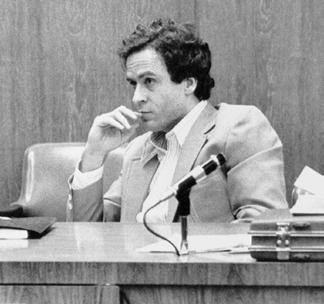
On the other hand, many believe that people are attracted to serial killers in order to try to understand why they commit such violent crimes. Human nature is to empathise with each other, so we often find ourselves trying to justify their heinous acts, especially if we know they’ve experienced traumatic events throughout their lives.
In fact, many serial killers have experienced some sort of trauma, in 2005 a child abuse and serial murder study was conducted by Mitchell and Aamodt. They selected 50 serial killers from the United States who had some sort of sexual gratification involved in their killings. Childhood abuse was categorized as abuse suffered by an
individual when they were under the age of 18, they divided childhood abuse into three subgroups; physical abuse, sexual abuse and psychological abuse and neglect. They concluded that childhood abuse is far more common across serial killers than the general population, except from neglect. Their results showed of the 50 serial killer participants, 36% suffered physical abuse, 26% sexual abuse, 50% psychological abuse, 18% neglect and just 32% reported no abuse at all.
Childhood trauma could be an explanation for some serial killers need for attention and media coverage is one way to gain attention fast, potentially making it a motive. On the other hand, some criminals are attracted to the feeling of power that accompanies high profile cases, this is particularly prevalent within male serial killers as a motivator. Regardless, we know that serial killers spend a hugely significant amount of time crafting their public images, whether it be by leaving letters and markings or by maintaining a pattern within the method of their crimes, watching the world glorify them fuels their desire to continue and even opens the doorway to other individuals who envy the spotlight.
So why is media such a dangerous catalyst to crime? Larry J Seigel’s Social Learning Theory proposes that “human behaviour is modelled through the observation of human social interactions, either directly observing those who are close and from intimate contact or indirectly through
media”. This suggests that by exposing the public, specifically those who are vulnerable to aggression, to so much crime, we may induce criminal behaviours in more individuals. Another theory Seigel introduced was Social Reacting Theory, the view that “people become criminals when significant members of society label them as such and they accept those labels as a personal identity”, so even if someone was falsely suspected of a crime but not convicted, they could be conditioned into believing they are a criminal and turn to something they may not have previously.
A study that suggests that media has a large-scale impact on the nature of crimes committed was a piece of research carried out by Rios and Ferguson about how media coverage of violent crimes affects homicide perpetrated by drug traffickers in Mexico based off the general aggression model. Exposure to media coverage of violent crime triggers the development of aggressive attitudes through desensitisation, someone previously not violent becomes violent - and the copycat theory - offenders mimic behaviour they see, showing that although crime rates in themselves stayed the same, criminals do tend to copy the worst of what they see in attempt to gather attention and notoriety to intimidate enemies.
To say that the media encourages crime is inaccurate, however it is clear that for many killers the speculation that surrounds being involved in a high profile case can be a main motivator; and for the general public, we have a tendency to get so engrossed in the intricacies of the crimes that we become desensitised and forget the victims and how they and their families have suffered enough without their trauma being aired to the world. Should news outlets, blogs and platforms for sharing be allowed to publish such sensitive information and articles? A straightforward answer is near impossible to reach, however a personal conclusion may be reached rather easily - do you believe that media has a significant impact on murder?
10
[P]eople are attracted to serial killers in order to try to understand why they commit such violent crimes.
Ted Bundy
Can animal therapy reduce the effects of dementia?
Dementia affects over 50,000,000 people worldwide and as of yet there is no cure for any Alzheimer’s disease and related dementias (ADRD), the only treatments manage the symptoms. There are four types of dementia:
• Alzheimer’s disease
• Frontal Temporal dementia
• Vascular dementia
• Dementia with Lewy bodies
The most common symptoms are Behavioural and Psychological symptoms, BPSD – agitation, aggression, psychosis, anxiety and depression. Usually, they are given drugs like Donepezil to help manage symptoms, but the side effects, for example dizziness, can lead to hospital admissions. On top of that, caring for someone with an ADRD can be time consuming and stressful and caregivers have a high risk of depression as, especially in late stage ADRDs as the person can become totally dependent and full-time care is required, the demand of looking after someone who can become increasingly irritable and difficult can cause caregivers to neglect their own health and wellbeing,
ADRDs are caused when the cerebral cortex is damaged. In Alzheimer’s disease, the most common form of dementia, nerve cells die causing the brain to shrink, meaning that the whole brain and all its functions are eventually affected, but the cerebral cortex is the earliest part of the brain to be damaged. This is very problematic as this is where much of our higher order cognitive functions come from. It is made up of four lobes: the frontal lobe which manages thinking, the temporal lobe which manages auditory processing, the parietal lobe which receives sensory information and the occipital lobe which manages visual processing. The cerebral cortex makes us who we are and during dementia it is the first part of the brain to be affected, which is why many families can find it so hard to watch as the person they loved starts to slowly disappear; starting with forgetting memories, then losing control over their emotions, thinking deteriorates and eventually leads to that person passing away. Whilst there is
currently nothing that can cure ADRDs, reducing the effect of the symptoms can make a real difference to help a person suffering with dementia enjoy the time that they have left and reduce the emotional strain that loved ones of a dementia patient must go through.
Bryanna Streit, a researcher from Florida Atlantic University, has investigated the effect of an interactive toy pet on the BPSD and cognitive status of adults over 50 with Alzheimer’s or dementia. The goal of the study was to increase positive emotions, reduce risk of depression and improve cognitive status using a non-pharmacological approach which is safe, affordable, non-invasive and comes with no side effects. The use of toy pets rather than real pets eliminated potential concerns about the wellbeing of the animal and the owner.
Twelve people with mild-severe dementia from South Florida Adult Day Centre received a “Joy for all” companion pet cat which they used twice a week over twelve visits for one hour. The toy interactive pet (TIP) that was used in this study was a cat and only two participants initially expressed they would prefer dogs but later said they would make an exception after
naming and forming an attachment to their robotic cat. The TIPs provided a sense of comfort, entertainment, a companion and provoked conversation with other participants about memories of past pets. Results found that all mood scores improved over the 12 visits and 67% scored higher on their MMSE, mini mental state examination, which is used to measure cognition. Research suggests that potential benefits of implementing pet therapy could lead to a decrease in verbal aggression as well as the other symptoms which could make caring for ADRD patients a lot easier for caregivers.
The idea of animal therapy is a historically used idea: the ancient Greeks and physicians in the1600s are both thought to have used horses to lift the spirits of the severely ill, Florence Nightingale supported the use of animal therapy for psychiatric patients, she wrote in her book Notes on Nursing that “a small pet is often an excellent companion for the sick”, trips organised by the American red cross to look after farm animals were used for veterans suffering from trauma in the 1940s and small animals have been used to calm children down in hospitals. However, it was only formally researched in the 1960s when Dr Boris Levinson noticed that his dog had a positive effect on his young mentally impaired patients.
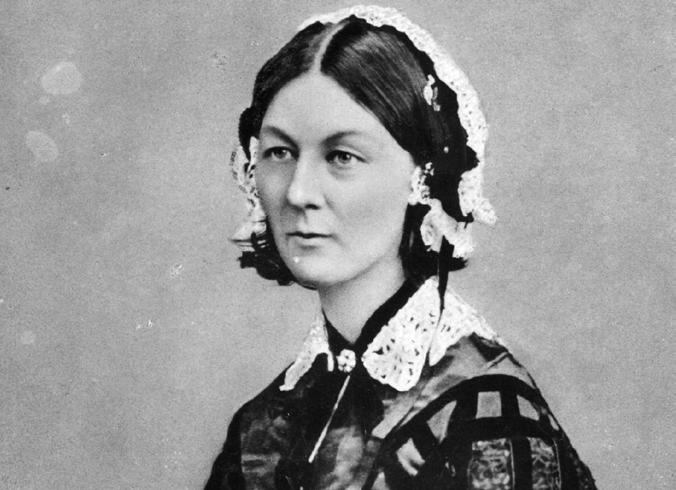
This article was published in the ATP Today magazine
11
[A] small pet is often an excellent companion for the sick.
Upper Sixth Izzy Jupe
Florence Nightingale


 Josh Rowley (A Level)
Lucia Martin (A Level)
Josh Rowley (A Level)
Lucia Martin (A Level)
12
Katherine Withers (GCSE)
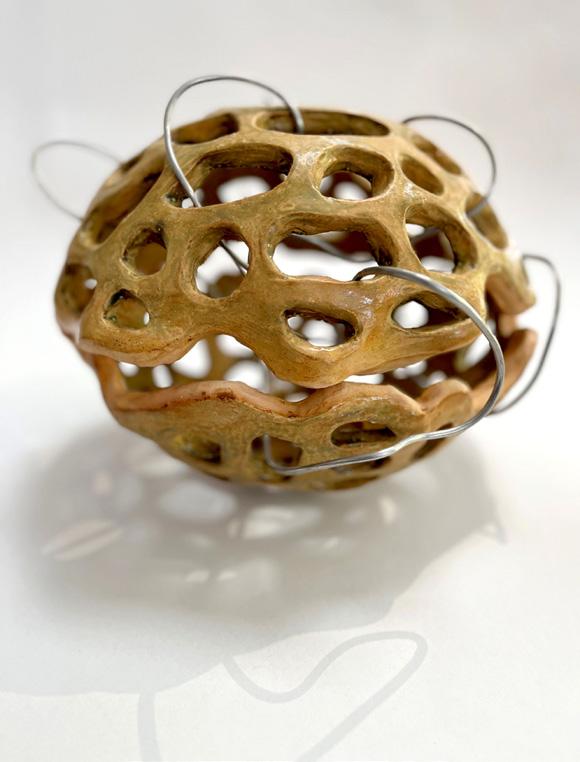
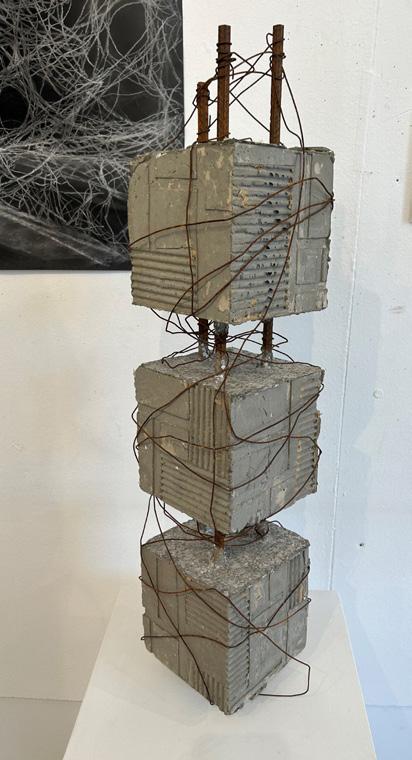
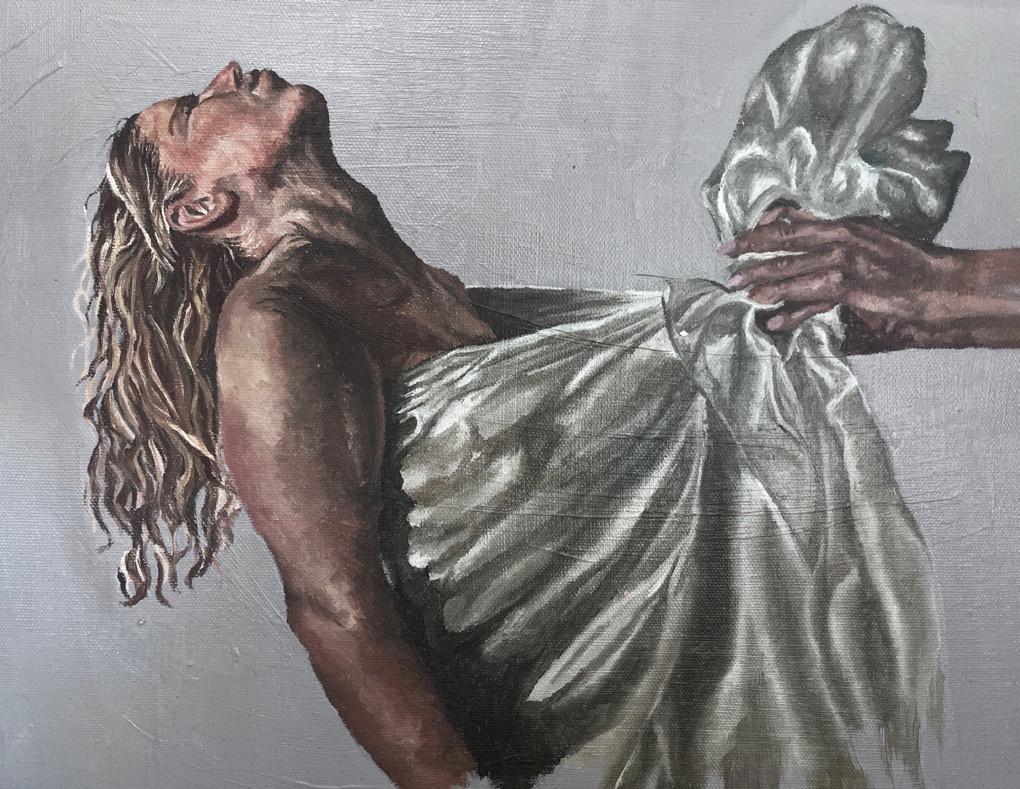
Bo Texier (A Level) Jess Watling (A Level)
(A Level) 13
Phoebe Hammond
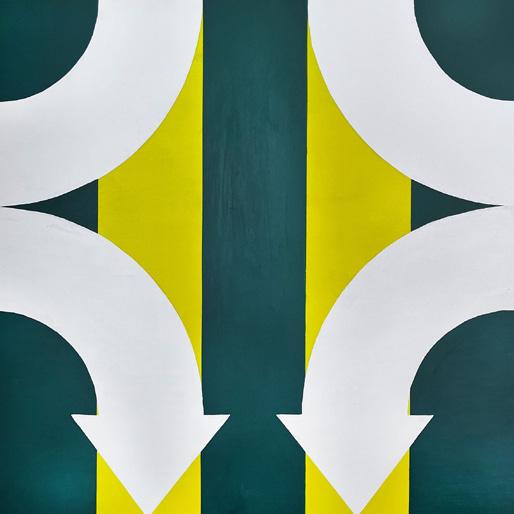
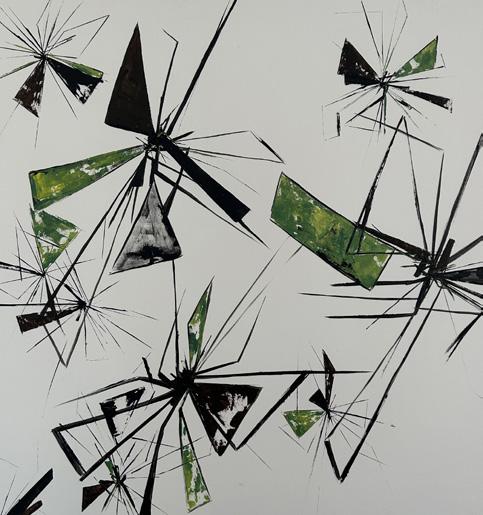
 Charlie Angel (A Level)
Natalia Schmitt (A Level)
Charlie Angel (A Level)
Natalia Schmitt (A Level)
14
Bella Gaunt (GCSE)
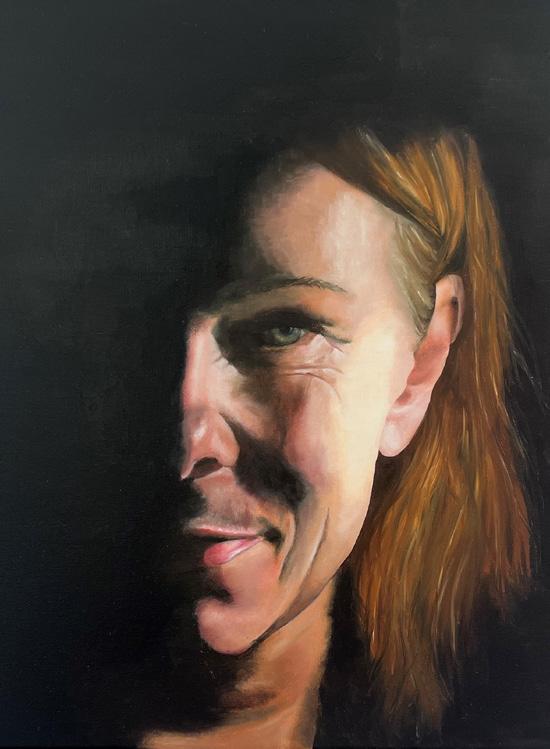

 Chrissie Holligon (A Level)
Sophie Knowles (A Level)
Chrissie Holligon (A Level)
Sophie Knowles (A Level)
15
Abigail Svarovska (A Level)
An Analysis of the Representation of Conflict in Modern Art
Georgia Humberstone
Upper Sixth
Over the last century, we have seen as much war as ever, fought the most global and bloody battles in history, and built more mass graves than one could have ever imagined. Artists, however, have always been able to create from these atrocities, whether from their personal trauma or general frustration at the cyclical nature of human history. But why do artists seek to relive their trauma? Why do they look to shock their audience? Why do they fight what cannot be fought – human nature?
Of course, this all depends on the artist. Where Anselm Kiefer may aim to reclaim his culture from the clutches of Nazism, On Kawara may question the meanings of life and death. Where Mona Hatoum may despair in noting that wherever there is humanity there is conflict, Simon Norfolk may point out the repetitiveness of our past. Whatever personal or external inquiries they follow, there is one thing that brings them – and the rest of humankind –together: war.
Anselm Kiefer:

When considering the wars of modern history – and the atrocities that ensued –one cannot ignore World War II and, by default, Nazism and the Holocaust, both of which are explored extensively in the vast oeuvre of Anselm Kiefer. Taking inspiration from the work of Jewish poet Paul Celan, who himself was incarcerated in a forced labour camp during the war, Kiefer has created several pieces exploring the legacy of the holocaust, including the works ‘Sulamith’ and ‘Margarethe,’ named after the contrasting Jewish woman and ‘Aryan’ woman in Celan’s poem ‘Death Fugue.’
Kiefer’s use of materials portrays both the physical traits of the characters of Margarethe and Sulamith and the lives of the real people that they represent.
In ‘Margarethe,’ the straw used evokes the eponymous character’s “golden hair” and in ‘Sulamith’ the black painted straw imitates the Jewish woman’s “ashen hair.”
In ‘Margarethe’ the straw is partially blackened, still in the process of burning as its candle like flames slowly eat at the straw. Totally burnt in ‘Sulamith,’ the straw illustrates the destruction wrought on Jewish people in Nazi-occupied Europe, both figuratively as a symbol of wreckage
and literally as a reference to the thousands of Jewish people burned alive by the Nazis. In ‘Margarethe,’ the partial burning of the straw shows that while the persecution of Jewish people by the Nazis did not directly endanger “Aryan” Germans (so long as they complied), it portended an overwhelming loss of European culture and identity for which all Germans would be the poorer. Echoing the sentiment of another poem on the Holocaust, ‘First they came’ by Pastor Martin Niemöller (Niemöller, 2019), Kiefer shows through these paintings that, as the straw is still burning, the Nazi regime, had it not been defeated, would only have continued to seek out and destroy different ethnic, political and religious groups until all there was left to destroy was itself. This is Kiefer’s way of warning coming generations of the danger of the incitation of racial hatred – the promises of the instigators are never true, hatred never benefits the ones who hold it in their heart, it devours them from the inside out, causing only pain.
Another way in which Kiefer investigates his homeland’s past is through the reclamation of elements of German folklore that were corrupted by Goebbels’ propaganda machine. A work exemplary of this is ‘Siegfried’s Difficult Way to
Brünnhilde,’ the title of which refers to Wagner’s epic ‘The Ring Cycle’ and the hero Siegfried’s journey to his lover. Depicting a railway bed, the photo is painted with sporadic splotches of monochromatic acrylic and gouache, and at the top is written the title of the piece. The motif of a railway bed is used frequently throughout Kiefer’s art, suggesting Auschwitz and its infamous railway tracks. Such abhorrent connotations take the viewer instantly to one of the darkest times in recent human history, without directly referring to it. It is rendered even more sombre by the total lack of colour in the image. Contrasting the journey of condemned people towards concentration camps or death camps that they are not likely to survive, with that of the protagonist Siegfried in one of the most iconic German-language operas of all time demonstrates how great German history could have been but how harrowing it really was. In this way, it seems as if Kiefer is mourning his country’s potential for artistic greatness, as, after the Holocaust, Germany’s art will be overshadowed by national guilt.
Kiefer’s work is inextricably linked to the legacy of WWII and its associated
[T]he horror that he saw and heard stayed with him forever.
16
‘Margarethe,’ Anselm Kiefer
atrocities. He seeks to confront his country with its past through his art, so that one may never forget. After all, “Those who cannot remember the past are condemned to repeat it” (Santayana, 1906).
On Kawara:
Like Kiefer, On Kawara knew what it is like to grow up in the rubble of a vanquished empire. Older than Kiefer, he witnessed the atrocities of war as a child. He was 13 years old when bombs dropped on Nagasaki and Hiroshima in his native Japan – and the horror that he saw and heard stayed with him forever.


His conceptual art was strikingly original, existential, and consistent, always working with time – or against it perhaps? A millennium, a year, a day; Kawara used the obvious tools for measuring life, but he used them in unconventional ways, he measured his life in days – not years – and he measured those days in people and places – not hours or minutes. Obsessed with time, Kawara incorporated the questioning of it into every aspect of his practice, revealing his misgivings about the purpose of life. Having grown up during a time when so many people died, it was inevitable that he questioned the reason he lived, and they did not. It could have easily been his city annihilated by an atomic bomb, but, for whatever reason, Tokyo survived with On Kawara in it. Luck, perhaps? Fate? Kawara’s investigation into humanity’s quantification of the universe is his way of questioning existence itself. Years and days are inventions of humanity,
not universal truths, and so, by questioning these things, Kawara shows how small and insignificant humanity is. We can try, but we will never understand why we are here.

Kawara’s best-known work is his monumental series of Today paintings, numbering just under three thousand by the time he died at 29,771 days old (Weiss et al., 2015). The idea of this series was to create a painting of the date every single day before midnight, white text on a variety of dark coloured backgrounds. Simple and meditative, this task was a life-long observation of the passage of time, noting each new day that he lived. The limited use of colour in the Today paintings keeps the focus on the date, rather than what happened on that day, showing that for Kawara all that mattered was that he was “still alive” (Kawara, 1973). Given his childhood in a country at war, perhaps the idea that all that is important is that he is alive comes from survivor’s guilt. No matter how difficult a singular day was for Kawara, at least he was alive, he could not say the same for others.
Also questioning human quantification of time is Kawara’s work One Million Years, a two-volume book project, of which the first book is titled ‘Past’ and dedicated to “all those who have lived and died” and the second book is titled ‘Future’ and is “for the last one”. Exhibited as an installation in which two people, a man and a woman, take turns to read a line starting with ‘Past’ and ending with ‘Future’, the books list every year from a million years in the past to a million years in the future (at the time of writing). As the books are read out, a normal human lifespan lasts just a few lines, demonstrating the fleetingness of life. In the grand scheme of the universe, we are all incomprehensibly tiny blips. This way of thinking about life was likely prompted by his childhood. Seeing all that death and suffering, he could not have helped but question the meaning of life and death itself.
Overall, On Kawara’s startlingly strippedback art style marks him as one of the most original conceptual artists of the 20th Century. His themes of life, existence and time were irrefutably influenced by growing up in Japan in the first half of the 20th Century, a time of political turmoil, war and death, which caused him to question the meaning of staying alive when so many people were dying.
Simon Norfolk:
While the world has not since seen war to the extent of WWII, where there is humanity, there is war. Responding
‘Sulamith,’ Anselm Kiefer
‘Siegfried’s Difficult Way to Brunnhilde,’ Anselm Kiefer
17
‘Today Painting,’ On Kawara
to modern conflicts, Simon Norfolk’s photography exposes the repetitive nature of human history and contrasts the natural world with humanity’s sins, creating a sense of despair at the inevitability of yet more war, yet more pain. A vocal critic of the United States, Britain and NATO’s military engagements in the Middle East, particularly in Afghanistan, Norfolk’s remarkable works expose these wars as neo-colonial lies. By all accounts against war, Simon Norfolk’s work also puts humanity’s conflicts in context with the world that we live in. Even if we move on, nature remembers.
One of Norfolk’s most striking works is his “collaboration” with the Irish photographer John Burke (1843? -1900) who took the first ever photographs of Afghanistan, documenting the British empire’s first contact with the “mountainous and secretive” country (www.simonnorfolk. com, n.d.). While, being Irish, Burke was somewhat of an outsider from the imperial hierarchy, his photography served the British Empire by painting the war in Afghanistan in the light of white saviourism. Take, for example, the above pair of photographs: on the left is a photo taken by Burke of the Khan of Lalpura (a warlord), his followers, and his English
“handler” and on the right is Norfolk’s contemporary echo of this, members of the Afghan Airforce with their trainer, Maj. Jason A. Church of the US Marines. Both photos are examples of white people advising and training Afghans ‘in need’. Of course, things had changed: the nature of the conflict was different than before, but in noting the similarities between the two wars (the white foreigner training Afghans to fight in a war that they did not

start or even want), Norfolk shows that the mentality of westerners towards poorer, culturally different countries had not really changed, they were still seen, at least by the politicians who had any say in the matter, as countries that needed to be ‘civilised’.
Another of Norfolk’s stand-out photographs is that of an aluminium waste pond at a factory complex in Karakaj, on the border of Bosnia and Herzegovina and
 ‘Future leadership of the Afghan airforce’ Burke & Norfolk
‘Future leadership of the Afghan airforce’ Burke & Norfolk
18
‘Aluminium waste pond at the Karakaj aluminium factory complex,’ Simon Norfolk
Serbia. Published in the monograph ‘Bleed’ (Norfolk, 2005), the photograph seems to represent just that – blood. Contrasted with the snowy white canvas of the countryside is a red pool of manufacturing waste, sitting in the landscape like a deep wound. But this wound in the land is not just an illusion, this landscape is truly scarred by the atrocities and war crimes committed during the Bosnian War. One event in particular is the reason Norfolk photographed this scene: on the 14th of July 1995, hundreds of Bosniak Muslim men, some of whom were minors, were executed at the aluminium plant and thrown either into mass graves or into the lake. Of course, looking at this photograph, the viewer knows in their mind that it is not real blood, but the resemblance is haunting. Nature plays its part too, the white snow blanketing the land like the skin of a colourless, lifeless corpse. The leafless shrubs forming a natural barrier between the viewer and the stage of the mass execution, begging us to leave it alone, to let it heal. Humanity will not leave it alone though – there is still aluminium production taking place in the border town of Karakaj. Hence, all that this landscape has seen from humanity in recent years is destruction, whether of itself, with war and hatred, or of the landscape, through aluminium manufacturing, the process of which relies on fossil fuels (IEA, 2022)). With this comparison of how humans destroyed other humans, and how humans are destroying the world, Norfolk paints a cynical image of humanity, as a ruinous species that brings only carnage.
While the other artists’ work I have explored was affected and influenced by war, for Simon Norfolk war is not just an influence, it’s the main subject of his art. Norfolk sees humanity as the executioner, devouring not just others of our species but the entirety of the world, in a constant, selfdestructive pursuit of power.
Mona Hatoum:

A daughter of Palestinians exiled in Lebanon after the 1948 Arab-Israeli War, who later immigrated to London due to the Lebanese Civil War, artist Mona Hatoum knows what it is like to be displaced by conflict. Encompassing expatriation, separation and loss caused by war, Hatoum’s work transcends cultural barriers and tells a truly human story of conflict, unrest and the way it changes lives forever.
One of Mona Hatoum’s most intimate and personal works is her 1988 ‘Measures of distance,’ a film comprised of four layered elements: in the background play nude photos of her mother in the shower which
are somewhat concealed by Arabic text –correspondence between Hatoum and her mother – layered on top of it. The audio is a taped conversation in Arabic between mother and daughter in which they talk freely about their feelings, sexuality and about fragile masculinity. The conversation is intercut by Hatoum reading her mother’s letters in English. Being nude, the film becomes a deeply intimate portrait of Hatoum’s mother and their relationship as it lets us see the real person without any barriers. In Hatoum’s reading of the letters, her mother tells her that her father was angry about the photographs, as if he owned her body and felt that Mona had infringed his property. Yet, at the same time, she gave her daughter full permission to use the images in her art, as long as Mona did not tell her father. In this way, the film subverts the stereotype of an Arab mother as a non-sexual, passive person by presenting Hatoum’s mother as a woman
who has sexuality and is rebellious in her defiance of her husband’s wishes. That being said, the text layered over the images, partially concealing them, shows that she is not just sexual, she is intelligent and she has a personality; basically, it demonstrates to the audience that Hatoum’s mother is a full person with an identity and not just what misogyny and colonialism might teach us about an Arab mother.
Although the most obvious subject in the film is Hatoum’s relationship with her mother, it also reveals the effects of war on her. As we come to the end of the film, Hatoum’s mother writes to Hatoum telling her about how lonely she has become due to the war. She is isolated from her children, who cannot return to Lebanon because of the war and she can hardly even visit her family that lives in Lebanon due to the danger outside of her home. Illustrating how war and displacement cuts people
19
‘Hot Spot III,’ Mona Hatoum
off from their support systems, rendering them even more vulnerable to the traumatic mental effects of conflict, Hatoum is denouncing the war for the pain it has caused her family.
Another artwork by Hatoum that deals with war, ‘Hot Spot III,’ a globe made of metal adorned with continents of neon lights, demonstrates Mona Hatoum’s despair at humanity’s unrelenting pursuit of war. The title of ‘Hot Spot’ refers to a term meaning a place of military or civil unrest. By delineating the continents in red neon lights, red being a symbol of danger, Hatoum suggests that the whole world is a ‘hotspot’. If the whole world is a ‘hotspot’, then war is an inevitability of human nature, and wherever we go, war and its atrocious consequences follow. The curved metal bars that make up the globe suggest a cage, as if the world is trapped within this
endless cycle of war. The idea that all of humanity, no matter where we are on the planet, is trapped in a repetitive pattern of war illustrates Hatoum’s disappointment with humanity, as it has consistently failed not just her and her people, but also everybody else that has been touched by the devastating hand of war.
Although war is not the main theme in all of Mona Hatoum’s work, its sinister influence can be found throughout all that she has done. For example, ‘Measures of Distance’ shows that although life goes on where it can, once you are affected by war, its presence is always there.

‘Hot Spot III’ however is a work directly confronting war and its consequences. Overall, in exploring war, separation and culture, Hatoum’s art demonstrates the persistence of war and shows despair at the apparent inevitability of it and its consequences.
Conclusion:
From WWII to the Lebanese Civil War, the representation of conflict in modern art screams out at the viewer, begging us to not repeat the pain of the past. Obsessive with his warnings for his country, Anselm Kiefer’s work is an obvious example of this plea. In confronting Germany with its atrocious, deadly past, for example in his works based on the poems of Paul Celan, Kiefer aims to protect the world from the repetition of such destruction. However, artists Mona Hatoum and Simon Norfolk know that this is a fruitless effort. In Hatoum’s eyes, war is an inevitability of humankind, evidenced by her work ‘Hot Spot III.’ At the same time, Norfolk’s work with the photography of John Burke clearly illustrates the repetitive nature of human history. Despite their belief that war will always persist, both Hatoum and Norfolk continue to expose the devastating consequences of war in an attempt to prevent it, fighting an impossible battle against human nature.
Whether war can or cannot be prevented is not the focus for On Kawara, in fact war is hardly even mentioned in his work. However, war’s silent presence within Kawara’s work is undeniable as the artist was forever changed by the war he witnessed in his youth. Kawara’s existentialism is a direct consequence of war and for this reason his work on time and existence shows the impact of conflict on modern art. Also showcasing the consequences of war is the oeuvre of Mona Hatoum, an artist forever displaced, whether that be from growing up as a Palestinian exile in Lebanon or from being forced to leave Lebanon for England due to the civil war. Both of these displacements become obvious in her work ‘Measures of Distance.’ Consciously or unconsciously, both of these artists present conflict in their art through its terrible consequences.
Having explored these artists, it has become clear that once exposed to war, artists cannot resist it’s influence in their work; Norfolk was compelled to examine motives behind war once he understood the reality of war in the Middle East, Hatoum has the pain of war in her genes, Kawara witnessed the desolation of his country, and Kiefer grew up in the rubble of his. From red hot globes to railway tracks, these transformative experiences are reflected in the oeuvre of each artist, thus leading to the simple realisation: war is a tenet of human nature, so is art. Hence, as sure as the sun will rise, there will be more war, more pain, and more art.
‘Measures of distance,’ Mona Hatoum
20
[B]oth Hatoum and Norfolk continue to expose the devastating consequences of war in an attempt to prevent it.
The Red String
Beth Roberts
Everyone seems to be looking for ‘the one’, a soulmate, someone to love forever, something that makes sense in a nonsensical and ever-changing world. Whether you’re a cynic or a romantic, everyone can appreciate a good myth.
Homer first speaks of fate (moira) as a singular power, but the poet Hesiod goes on to establish the Fates as three old women who spin threads to determine human destiny, often attributed to a particular time period, named Clotho (the spinner, present), Lachesis (allotter, the future) and Atropos (inflexible, the past). The Romans had similar ideas with Nona, Decuma and Morta. The Fates were portrayed originally as fatherless daughters of Nyx, but later as the offspring of Zeus and Themis. Orphic cosmology presents their mother as Anake. The women were frequently portrayed as old and ugly in literature, but in art they were often very beautiful. It is said that when a
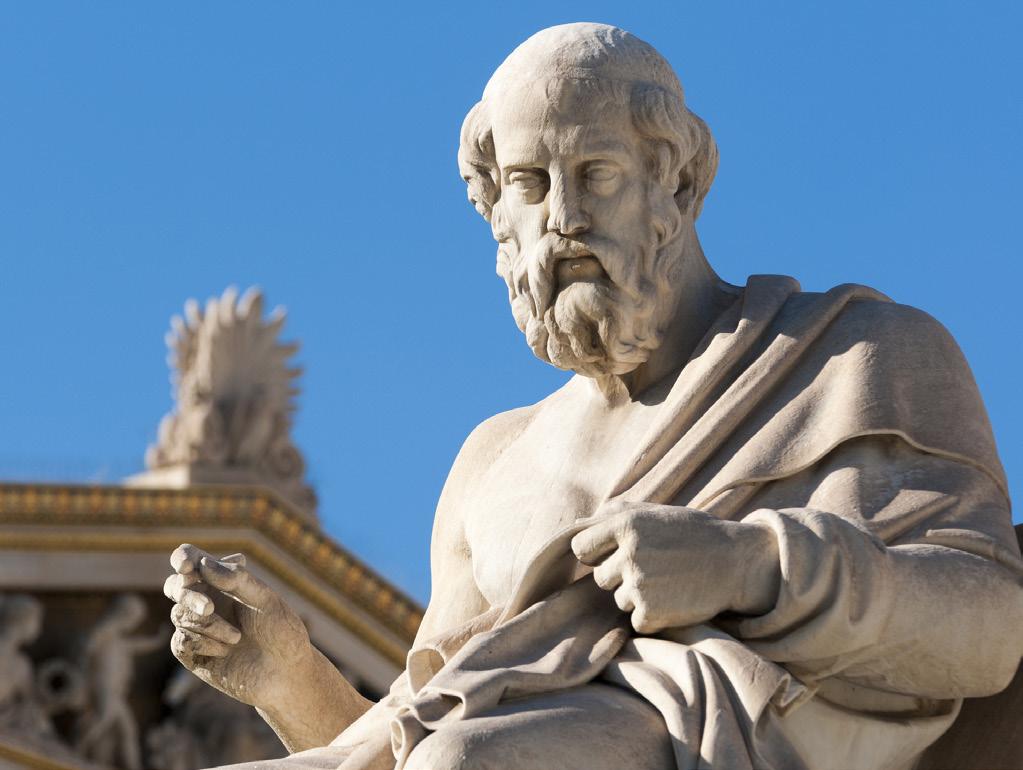
baby is born Clotho spins their life thread, Lachesis measures how long they will live for and finally Athropos cuts the thread with her shears when their life comes to an end. Together they represent inescapable human destiny and everyone’s threads make up a complex web-like tapestry.
The red string of fate is different to your main life thread and is featured in many different cultures. In Chinese mythology it is tied around the couple’s ankles, in Japanese culture it is bound from a male’s thumb and from a female’s little finger to their partners; in Korean culture the red thread is from each of their little fingers. In Chinese lore the deity in charge of the red thread is Yuè Xià Laorén, the ‘old man under the moon’, who seeks out couples to bind together in an unbreakable bond. In one story, a boy walks home on a dark night and meets an old man (Yuè Xià Laorén) standing under the moonlight. The
man shows the boy he is attached to his future wife by a red string, but the young boy, wanting nothing to do with romance, throws a stone at her. Many years later the boy has grown up into a young man and his parents arrange for him to be married. When he meets his bride and lifts up the traditional veil covering her face, he notices she is wearing a strange piece of jewellery above her right eyebrow and when he removes it he sees the scar beneath where she says a boy threw a stone at her when she was young. This story embodies the belief that the red thread of fate connects two people destined to be together regardless of time, place or circumstance and although it may stretch or tangle it never breaks. Chinese culture celebrates the symbolism of the colour red by featuring it in weddings where the bride and groom wear it throughout or at some point during the rituals. The red thread is very similar to the Western concept of soulmates.
21 Plato
Lower Sixth
In ‘The Symposium’, Plato discussed soulmates and explained that God created joined humans with four legs, arms and two faces. These beings were prideful and wanted to overthrow the Gods, so Zeus separated them as a punishment by splitting them in half and putting their genitals on their backs. These newly separated humans wandered the Earth looking for their other half in devastation. Over time, the humans became miserable from loneliness and with the inability to find their other half they starved to death. Apollo took pity on the humans and stitched them where they were cut apart, moving their genitals back to their front so that heterosexuals could produce offspring as offerings to the Gods and both they and homosexuals could find love and happiness. Some continued the search and found their soulmate, but most found contentment with another.

The issue of soulmates continues to affect society today, with people holding out for someone who might not even exist. There are many cases of relationships ending prematurely over very fixable problems or disagreements, simply because people have an unrealistic expectation of love. From a young age we are exposed to movies, books and articles that tell us what to expect from your partner and show us these perfect couples who never fight, and every story ends with a happily-ever-after straight from Disney. Humans are curious beings by nature and inherently selfish due to innate survival instincts. This makes for people who are too paralysed by fear to enter into a relationship that could possibly end, or people who are so focused on this idea of ‘the one’ that they sabotage good relationships, because they don’t match up to this perfect ideal in their mind.
The argument of “tis better to have loved and lost than never to have loved at all”, famously said by Tennyson, is one that plagues people even now. It would suggest in relation to soulmates that you shouldn’t spend your life searching for the person at the end of your red string and should rather not fear falling in love and attaching yourself to another person even if it’s not the person you spend the rest of your life with, because love is the strongest emotion of them all and one that everyone deserves to feel, so whether you lose or hold onto your love, it is better to feel something real than to hide from heartbreak.
The term ‘forever’ is continually misused in regard to love. People make these larger-than-life declarations with enough hyperboles to make astrological references
seem tolerable and forget that you cannot promise someone ‘forever’. Life is highly unpredictable; one of the reasons why many take comfort in ideas like fate is so that something is guiding them throughout their lives. Due to the unforeseeability of existence no-one can promise to be with someone for an immeasurable amount of time. Not only is it not physically possible given the human lifespan, but it is disingenuous to swear a never-ending future with someone when you are fully aware that will never happen. I suppose fate is a far more becoming alternative to life without such beliefs, giving your life some sort of meaning and worth whether you accomplish anything or not. There is a sort of blame sharing to it and a relinquishing of harsh memories in favour of a planned pathway that means all you suffered for will be worth it as everything will miraculously work itself out in the end so you will find happiness. I think this very optimistic view of life is somewhat naive, but very comforting, so I can understand why many people believe in it. To believe in an existence without purpose, meaning or any insight to your future is a very daunting
task, but when you choose not to believe anything or anyone has a plan laid out for you, you can seize control of your own destiny and give your life any purpose you choose. It is a very freeing experience when you choose to make things happen and not let fate decide things for you: carpe diem.
Therefore, in love and life, choose to create your own happiness, embrace new opportunities and don’t fear the unknown or possibility of ending up alone. Every decision you make and don’t make contributes to a million possible alternative realities and not making a choice is still a choice. Whether you meet the person at the other end of the red string or don’t, remember that if you open up your soul to another person, you might just find your soulmate, not as Greek mythology states it, but rather, someone who understands you like no other, who treats you with love and respect and as an intellectual equal, who you may not always like, but you will always love. In a world full of uncertainty and misfortune, we need to reclaim and reinvent the word ‘soulmate’ to be someone who isn’t perfect, but is right for you.
22
Clotho spinning life thread
As a cosmological concept, the idea of our universe as merely one parallel member of a much larger ‘multiverse’ dates back to the fifth century B.C., and a philosophy known as ‘atomism’. These Ancient Greek natural philosophers supposed that the universe was made up of tiny, indivisible particles called atoms, which determine not only the objects around us, but also our perceptions and emotions - it was thought that tastes were caused by the texture of atoms, and temperature caused by the atoms’ friction. It was suggested that our universe was the result of these atoms colliding randomly with each other in a vacuum that Democritus called “the void”, and that these collisions formed many other, less perfect, parallel universes. However rudimentary this explanation of the cosmos may seem now, it introduces the multiverse as one of humanity’s first attempts to explain the origin of our universe without the help of a divine creator. The current revival of this ancient idea has come as a response to some of the most perplexing mysteries about our universe facing modern-day physicists, due to its extraordinary explanatory power.
Although the multiverse seems to be a convenient answer to a lot of the questions we currently have, it is important to remember that the multiverse hypothesis is still only a hypothesis, and will remain so until we have conclusive evidence on which we can accept it as a scientific theory.
The enormity of a potential proof of the multiverse hypothesis cannot be overstated: string theorist Brian Greene describes such a proof as “the biggest upheaval of our understanding of cosmology since Copernicus proved that Earth wasn’t at the centre of the universe”.
How Likely Is the Multiverse?

Within the scientific community, many different hypotheses about the multiverse have emerged - physicist Max Tegmark attempted to categorise the various multiverse hypotheses into four ‘levels’ of multiverse as early as 2003, and the
James Restell
aforementioned Brian Greene went further in proposing nine levels of multiverse in 2011.
The numerous suggested multiverses illustrate the problem facing the multiverse hypothesis - its foundations in scientific conjecture. Some claim that belief in the multiverse is akin to religious belief in its complete lack of evidence. However, this argument doesn’t appreciate the perfectly rational scientific reasoning behind the modern revival of the hypothesis. If we take evidence as “that which justifies belief”, the fact that the multiverse explains many of the major astrophysical questions that are currently unanswered could arguably fit this definition, providing substance to the multiverse’s claim. In recent years, science has produced significant amounts of “suggestive evidence”, meaning “results that indicate a strong possibility of something without decisively proving it”, making belief in the multiverse hypothesis a potentially rational belief.
The Argument from Fine-Tuning Our universe appears to be perfectly suited to our needs, almost custom made for
human existence - to take one example, “if protons were just a fraction of a percent heavier, they would decay into other particles, and without protons there would be no atoms with which to make living things”. The same can be said for planet Earth, which seems to have been placed exactly the right distance from the sun to facilitate life. For many centuries these simple observations formed one of the strongest arguments for God as an explanation of the universe’s apparent finetuning. Logically however, this argument is fallacious - there are a vast amount of planets in our universe, and although most of these planets are uninhabitable, it is only logical that as an intelligent species capable of contemplating such matters, we must necessarily exist on one of the “perfect” planets. The multiverse hypothesis attempts to take this argument one step further. Given the incredible number of coincidences in the fundamental constants of the universe, one is tempted to assume an intelligent designer who created the universe. However, the multiverse hypothesis refutes this proposition by proposing a very large (possibly infinite) number of parallel universes. Now it is trivial to ask why the constants of the universe seem so fine-tuned; the very fact that you are asking the question means that you live in a universe which facilitates intelligent life, meaning you must find yourself in one of the few universes
How likely is the multiverse? Would it change anything if (somehow) we came to know the theory was true?
Upper Sixth
Some claim that belief in the multiverse is akin to religious belief in its complete lack of evidence.
23
An artist’s impression of the multiverse
fine-tuned for life. This argument for the multiverse is effective in removing the need to resort to baseless explanations for our universe such as God or sheer coincidence.
Cosmological “Evidence”?
The possibility of a multiverse is mainly supported by three branches of physics, which all independently seem to point to a multiverse – these branches being quantum mechanics, string theory, and the observation of our universe’s ‘eternal Inflation’.
Quantum Mechanics
In 1957, Hugh Everett published a paper suggesting the many-worlds interpretation of Schrödinger’s famous wave function, which was later popularised by Bryce DeWitt in 1970. Simply put, DeWitt proposed that whenever a quantum superposition “collapsed”, the outcome isn’t randomly chosen - instead there are universes in which all of the possible outcomes happen, and we just find ourselves in one of them. This interpretation of the wave function is important as it re-introduces determinism into the universe – but it also suggests that parallel universe exists for every quantum superposition in our universe.
String Theory
String theory is a branch of theoretical physics that attempts to harmonise two conflicting areas of physics: Einstein’s
theory of relativity, and quantum mechanics. String theory supposes that the behaviour of all particles is governed by a minuscule string inside the particle, whose vibrations determine everything about the particle. String theorists suggest that these strings exist in 10 or 11 dimensional space, and can be configured in a huge number of different ways. Whilst we can’t represent these dimensions physically, when we use mathematics to represent these dimensions, we are left with as many as 10500 possible configurations (each corresponding to a possible universe), a number so large that we can think of it as a de-facto infinite multiverse.
Eternal Inflation
In 1998, three scientists proved that the rate of the expansion of the universe was increasing. This begged the questionwhy? It has since been theorised that this force of ‘repulsive gravity’, comes from ‘dark matter’, a type of matter completely invisible to human observation, and that “we only assume exists because without it, the behaviour of stars, planets and galaxies simply wouldn’t make sense”. The exact amount of dark matter that must be present in the universe to account for this repulsive force is staggeringly small, and seemingly random. How then do we come to live in a universe with just enough dark energy that it doesn’t collapse in on itself, but not so much that matter is forced apart before it can ever form? The multiverse hypothesis
elegantly answers this question in the same way proposed by the argument from finetuning.
Summary
The more we learn about the universe we live in, the more questions seem to arisequestions that, for now, are recognised as scientifically unanswerable. This idea may seem uncomfortable to us, but to assert that the multiverse is a legitimate scientific theory with its complete lack of evidence seems to be against the fundamental scientific tradition of evidence-based belief. However, I propose that we cannot ignore the enormous explanatory power the multiverse holds just because we can’t observe it - without the multiverse, the current leading theories in physics are not compatible. “In the hard sciences, if an unobservable entity is theoretically useful, that is often seen as a reason to think it exists” - this line of argument can be applied to many cosmological theories like dark matter which are already widely accepted, and I propose that it is therefore rational to assert that the multiverse hypothesis is significantly more likely to be true in some form than not.
Would It Change Anything If (Somehow) We Came to Know the Theory Was True?
As well as the obvious scientific ramifications, there are an important range of philosophical consequences that we can address. The consequences are numerous,
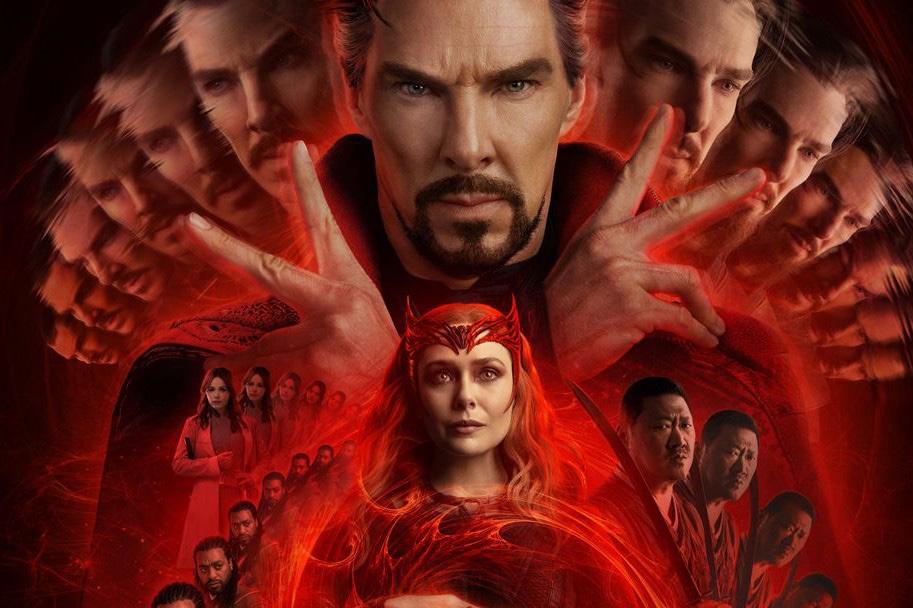
24
The multiverse hypothesis has received lots of attention in popular culture
Free Will
Some philosophers would take the view that parallel worlds “are all eliminative, materialist and deterministic” - this statement seems to remove any notion of free will in an infinite multiverse. Indeed, “the metaphysicians proposing possible worlds... do not believe in the existence of ontological possibilities in our world”. In some areas of metaphysics, such as David Lewis’ ‘modal Realism’, a person has many “counterparts”, each in a separate possible world, meaning that the decisions you make in this world become defined by the outcomes for which no other parallel world exists - i.e. you live in the parallel world containing your deterministic life, and a parallel world already exists for any other course of action you wish to take. The notion of free will is central to moral discussion - if agent’s do not have free will, they can have no moral responsibility, eliminating the need for moral discussion. A deterministic multiverse seems to take away our free will, but some philosophers argue that “free will is a consequence of not knowing which of the many possible worlds that we are in”, thus preserving our free will and therefore our moral responsibility.
Morality
How can we live our lives morally with the knowledge that we are just another permutation in an infinite multiverse? If we allow ourselves to consider an infinite multiverse with free will, we can see how the fact that “everything that can happen will happen, infinitely many times” has some interesting moral consequences. A moral absolutist would maintain that an infinite multiverse has no effect on morality - actions are objectively right or wrong no matter how many times they are performed, but this is just one of many moral frameworks. The infinite multiverse confronts us with the fact that for every moral dilemma that we face, a world exists in which we choose the “most moral” option, and for which we choose the “least moral” option. Why then should an agent bother to make sacrifices in this world in order to be more moral when there already exists a world in which they (their “counterpart”) are the “most moral” person? Alternatively, if by taking a moral decision, you simultaneously reject all other decisions, are all decisions other than the “most moral” decision immoral? An important question of identity can be raised here, relating to our counterparts in other worlds. If they are permutations of ourselves, could it be that for every moral decision, we don’t make a decision at all, instead the collection of our
counterparts will make all the possible decisions simultaneously. It seems that we make every moral decision at once, again calling into question the validity of the moral decision-making process. Agents in an infinite multiverse become stuck between knowing they are never being moral enough, but also knowing that whatever they do, they will never be the least moral version of themselves. An infinite multiverse seems conducive to moral nihilism - whatever action we take, our counterparts will have already made better and worse decisions than we didpotentially rendering our decision making process pointless.
Conclusion
I propose that, aside from the academic revolution the multiverse would bring, society would be greatly damaged by a proof of the multiverse, given the challenge it makes to our moral agency. The moral nihilism that the multiverse could induce in society would be devastating - with people realising not only their stunning insignificance in the multiverse, but also the futility of attempting to ‘do good’. Society would lose the incentive to sacrifice their personal ambitions and desires in the name of a greater moral good, instead opting for decisions which maximise their short-term pleasure. Society relies on its members acting for the benefit of the community, and I fear that the hedonistic consequences of this moral nihilism would be devastating for civilised society as we know it.

[W]e cannot ignore the enormous explanatory power the multiverse holds just because we can’t observe it.
but I will focus on what I see as the most widely applicable questions pertaining to free will and morality.
25
Brian Greene delivers lecture on the multiverse
The First World War and The Decline of a Collective European Culture
Dodson
Growing up in London, I used to always enjoy the inevitable after-school supermarket queue, not only because I always managed to persuade my parents to buy me whatever Cadbury’s confectionary caught my eye, but also because I used to love hearing the concoction of different languages and accents that bounced from trolley to trolley and into my ears. Although I could not yet understand a word of French, and my only understanding of Spain came from Cesc Fàbregas and Dora the Explorer, I still felt a part of something, a collective of people that had chosen this specific city to make their home. Walking around London, you are constantly reminded of the triumphs of European architecture and design, whether it be the majesty of St Paul’s Cathedral, the celebration of democracy that is the Houses of Parliament, or even the Tate Modern, a symbol of the might of the Industrial Age. They are buildings that stick out in a sea of concrete and high-rises and stand for

something more than merely an office; instead reminding us of the majesty of a bygone era, rising like a phoenix from the ashes of pre-industrial Britain. So, the real question is, simply, what happened? Why is the Europe of the modern age still entrenched in conflict while powers such as the United States and China are thriving? Simply put, following the First World War, Europe lost its sense of unity, divisions and borders were created that raised a generation on the distrust of their European counterparts, a distrust and uncertainty which still plagues the continent to this day. In order for Europe to thrive, it must regain this sense of unity and cohesiveness that was lost in war, to both
maintain the peace that is absent today and to work together to form a better future for the generations to come.
The reality is, in order to sustain peace, there must be an understanding, something that binds nations together that transcends language or proximity. Europe had this, outlined in Orlando Figes’ book The Europeans, wherein the invention of the railways bought Europe close together for the first time, allowing people in the Victorian age to share and experience cultures, new ideas and artistic movements previously relegated to newspaper reports. At last, there was peace on the continent, lasting from the end of the short-lived Crimean War (1856) to the
Freddie
Upper Sixth
Walking around London, you are constantly reminded of the triumphs of European architecture and design.
26
A view of The Houses of Parliament from the South Bank
fateful assassination of Franz Ferdinand in 1914. A period of peace that was not only impressive in the context of the time period (war was still seen as heroic and justifiable), but impressive in what was accomplished in its duration. Coinciding with the Industrial Revolution, Europe transitioned into the modern world with great enthusiasms; the great European cities came into their own, constructing their most famous monuments (the Eiffel Tower, Big Ben and many others), science progressed and radical artist movements such as Impressionism and Art Nouveau were celebrated in grand museums and decadent salons. Through the arts, Europeans grew to understand one another, understanding the differing experiences and cultures that made up the continent. Russian writers such as Tolstoy, Dostoyevsky and many others were translated into the major European languages for the first time, while French poets and writers, such as Baudelaire and Flaubert became common place in London bookshops.
But with the advent of the First World War, this sense of collectiveness, trust and understanding of our neighbouring nations was lost. Not only did the war show that Europe had not progressed, still favouring shells and shrapnel as the primary form of international diplomacy,
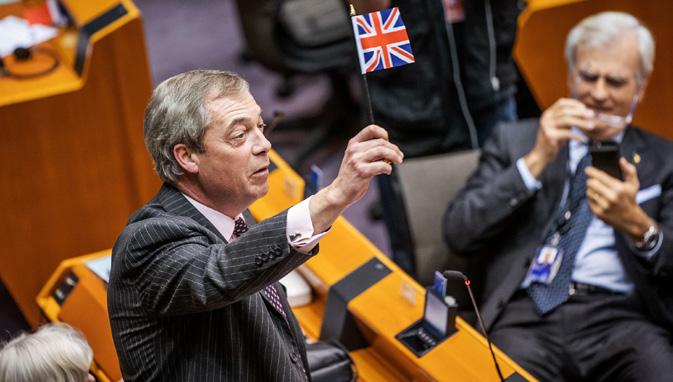

but it also marked a split in the ideologies of Europe. Following the war, the continent was not only politically in tatters, but was economically ruined. Both became entrenched in a severe recession, becoming reliant on the United States for trade and economic aid through membership of the 1919 International Chamber of Commerce (ICC), while nations such as AustriaHungary, the Ottoman Empire, Germany and Russia systematically collapsed. This paved the path for the rise of the Fascists in Hitler, Mussolini and Franco, becoming the yin to the growing USSR’S Communist yang. Instead of uniting under the universal horror experienced from war, Europe
instead became an ideological battlefield, raising a generation on the distrust of foreign cultures and ideas that opposed their own. In terms of the arts, art was not only supressed, but was given a nationality and passport; its circulation restricted by its country of origin rather than by its value and merit. In Nazi Germany contemporary art was termed ‘Degenerate art’ and was subsequently banned. This meant that artist such as Max Beckmann, a painter who pushed the boundaries of art and would normally be celebrated in the salons of Europe like the impressionists that came before him, was instead forced to flee to America, along with many of his
The amount of money needed to buy a loaf of bread during the peak of Germany’s hyperinflation
27
Nigel Farage waving the Union Jack at the end of a pivitiol EU meeting
peers. Likewise, in Soviet Russia, the writer Mikhail Bulgakov had his radical work supressed and outright banned, forced to have his masterpiece The Master and Margarita published in 1966 by his widow, 26 years after his death. Subsequently, A Virginia Woolf novel would not be found in Moscow, and likewise, a Mikhail Bulgakov play would not be performed outside of the USSR. Unlike the generation before, the paintings, sculptures and books that helped those of the Victorian age understand the differing identities and experiences of their neighbour’s, from Dickens to Tolstoy, were lost. The effects of this generational separation are present even today, you only have to go to a football match between England and Germany and listen for yourself. Chants such as the now infamous ‘Ten German Bombers’ may seem like surface level banter, but actually express how there is still a black and white view of allies and enemies cultivated during the war that extends to the present day. Moreover, to take a more practical example, before the outbreak of the Russo-Ukrainian war if you went to a public space and
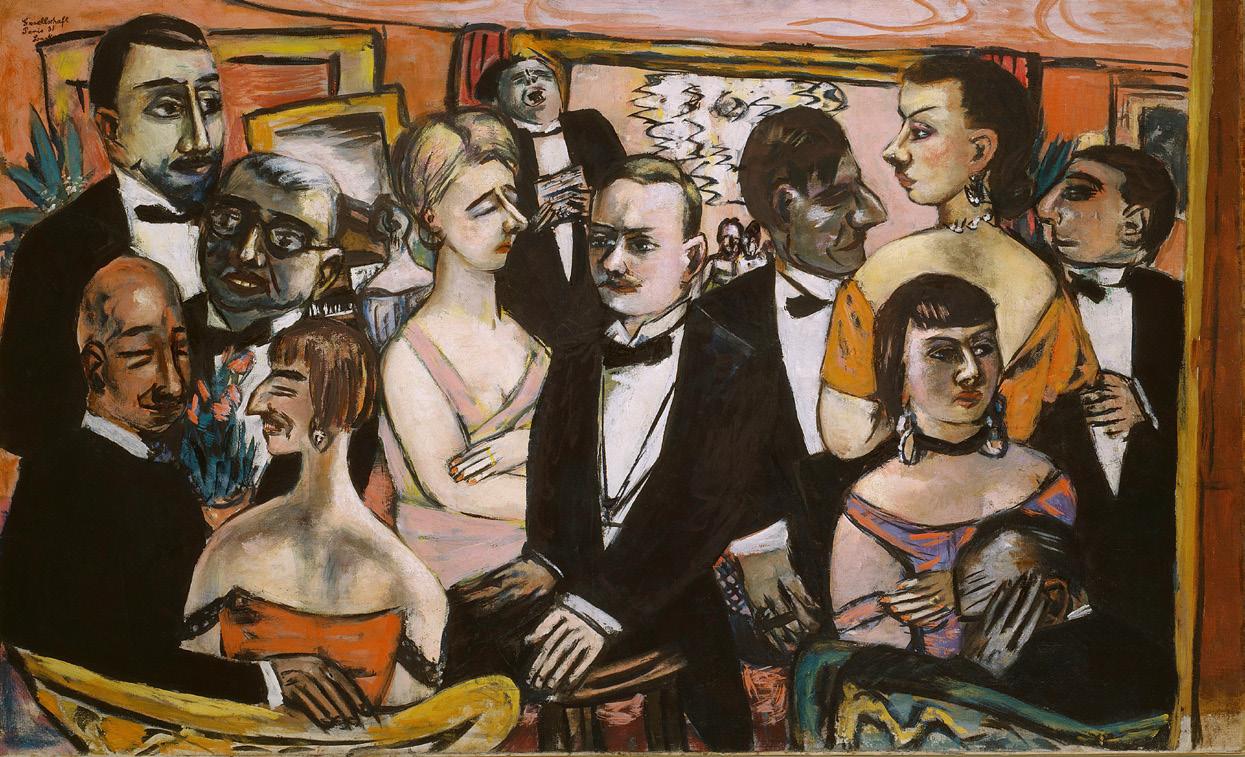
loudly uttered the words “I cannot wait for my holiday to Moscow next month”, you would be sure to get a few inquisitive or disapproving looks. This pejorative view of Slavic and Russo-based cultures is generational, a sense of distrust and unease from anyone that grew up during the Cold War, and one that simply stems from fear of the unknown. A lack of understanding that should be obsolete in the modern age of easily accessed information, but ultimately one that shows just how devastating the impact of WW1 was, changing the fabric of Europe for generations to come. As historian Edmund Taylor summarises, “The First World War killed fewer victims, destroyed fewer buildings but in many ways it left even deeper scars. The old world never recovered from the shock”.
Ultimately it was the First World War that ignited the rest of the events of the 20th Century, a catalyst for the Second World War, the Cold War and the rise of the
United States. But most importantly it was the war that created divide, bias and fear of other European states that has lasted into the present age. After all, with the advent of Brexit, the migrant crisis and the Russian invasion of Ukraine, there is a sense of unease in the air, unease birthed from a realisation about just how divided Europe has become, how little we know about our European neighbours’ nations and the cultures they inhabit. The rise of the political right, embodied in politicians such as Nigel Farage, Marine Le Pen and the recently elected Giorgia Meloni, mirrors the rise of the populist leaders of old, championing the ‘everyman for himself’ attitude that serves to further divide the continent rather than unite it. It is a slippery slope that Europe will not want to repeat. However, in order to put an end to European divisions and unite once more we must seek to understand one another like those of the Victorian age and regain the collective culture that was buried under the mud and shrapnel of WW1. So, rather than arguing about Brexit, the migrant crisis or how best to deal with Russian oligarchs, perhaps we should also read a Dostoyevsky novel, look up a Cézanne painting or watch a Fellini film and maybe then we can prevent wars in the future and understand that we actually have more in common then we perhaps once thought.
[E]urope instead became an ideological battlefield, raising a generation on the distrust of foreign cultures and ideas that opposed their own.
28
A Max Beckmwann painting capturing the anxiety of a broken European culture
This essay aims to explore how artists can visually present movement in their work. Artists use several methods in order to encapsulate the idea of movement, either by visually presenting it with a subject’s form through built up tension, arcs and trajectories of movement or, alternatively, by subtly implying it through the piece’s composition or art style, using simplification and abstraction to highlight certain features. An example of this subtle presentation method is in Dan Scott’s, Three Boats at Kingfisher Bay (2016)
In this piece, he refers to “the repetitive contours of the water creating a sense of visual rhythm” (Draw Paint Academy). This ‘rhythm’ of the waves draws the viewer’s attention across the image, which parallels the movement of the current, further immersing the viewer in the landscape, despite it being a static image. Movement provides a piece with additional context and expression, which artists use to elaborate on how a subject interacts
Upper Sixth
with its environment, its physicality and anatomy. In addition to this, it can direct the focus around the image, which can be used to present scale, perspective, movement, distance, environmental features, and guide the overall tone of a piece. Furthermore, an important aspect to presenting movement is timing; as artists are trying to capture either a set point, or a progression through time, to convey how an image can change from one state to another.
There are many ways artists are able to portray movement in their work, depending on how they use different elements, given this can enhance a particular setting; as it provides extra context to the energy of the shot and highlights contrast of motion. An integral method of conveying movement is building up an image with
different dynamic shapes and lines. This can be shown with the squashing and stretching of forms to emphasise an action. The directionality of these actions can be derived from a line of movement, which centralises the movement to a fixed point, which is commonly seen along the spine or across a limb of a person or animal.
The shapes of lines and different forms can alter their impact within a piece. An example of this can be seen in Wassily Kandinsky’s work, who creates abstract multi-media illustrations that utilise ‘expressive diagonal lines with dabs and washes of colour’. Their intention was not of detail or accuracy to real life, but to convey emotion, implying that energy through the gestural marks on the page.
The contrast in the softness and direction of the lines in their work creates multiple
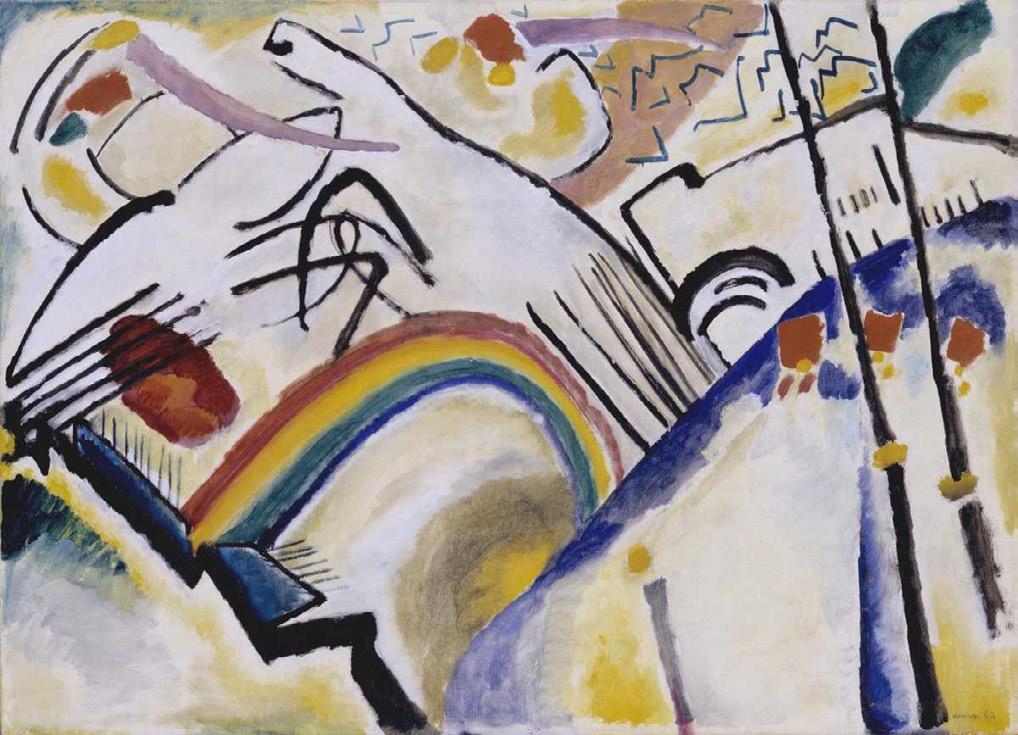
What methods do artists use to capture movement in their work and what does it add to it?
Josh Rowley
Their intention was not of detail or accuracy to real life, but to convey emotion.
29
Wassily Kandinsky
points of perspective within their image. This makes it appear as if different elements of the image have different energy and are clashing against one another. This contrasting aesthetic complements the vibrant colours and visually random aesthetic that is seen in Kandinsky’s work.
Artists also use methods like ‘scumbling’, in order to try and capture the intensity and built-up effect, that comes with the layering of different moving elements. This method can be seen in J.W.Turner’s painting Snow Storm, where he layers several colours and textures over one another to convey the sporadic form and tones of the storm. This disorientated setting creates an illusion of flexible depth, that moves the viewer’s attention infinitely far back into the image.


The diversity of the contours of the waves when meeting the clouds on the horizon gives the image its chaotic and clustered appearance. Furthermore, the image is portrayed with a slightly slanted fisheye perspective, which grounds the image within the intensity of its surroundings. The waves and clouds blend together to portray a surrounded and encompassing composition.
Furthermore, movement can be explored more abstractly through a focus on line. Examples of this can be when scenic elements are deconstructed to simplified shapes which represent the overall movement. This can be seen in the work of Leonardo Da Vinci, where he has simple line sketches that abstract the dynamics of water, exploring how a liquid interacts with itself and other elements when in motion, as it alternates between spreading out its energy and condensing it into small, concentrated areas of contact.
Overall, I think that deconstructing different parts of an image into its base shapes and outlines is an interesting and dynamic way for artists to present movement as motion can be conveyed more effectively by exaggerating the
shape of forms to follow the trajectory of an action.
Another important aspect of conveying movement in a piece is the positioning and perspective of the different elements of the image. When composing an image, the different elements in respect to oneanother can affect the energy of the scene.
An example of composition experimentation artists use to emphasise an action, is the distortion of form. An example of this can be seen by presenting different parts of an object in different focal grounds of the image. A photographer who experiments with this concept is Brian Korteling, who edits stagnant objects into a lively scene.
This contrast in motion and break in emersion adds energy by splitting a viewer’s attention around the image. In his piece Glitch (2017), the composition of encompassing foliage contrasting an open field in the background highlights the gap
J.W.Turner
30
Leonardo Da Vinci
between the focuses. By then editing in a cube that does not follow the rules of the image, such as not reflecting in the water, and having a defined silhouette rather than sporadic leaves, it creates a disconnect that has the viewer moving their focus into the image to understand the space in three dimensions. This gives the piece greater movement than if it were a still shot of a river surrounded by trees and fields.

Moreover, the perspectives and scale used in the image can play a major role in how the energy of an image is perceived. A work called The Parisien by Jasper Barrington Galloway explores this theme, by breaking up the image into different shapes. This makes use of splitting the viewer’s attention around the image, as the abstract perspectives make the viewer unable to properly perceive the image, never allowing the viewer to settle on a single part, forcing them to continuously change their perspective.
Composition can also be used to highlight the importance of different aspects of an image. An object’s position in the foreground and background can highlight its role within its surroundings. If an action is the centre point of an image, the motion will be much more apparent. However, if motion is a complimentary aspect of the image, it will be much more subtle, being present in the folds of
 Brian Korteling
Brian Korteling
31
Jasper Barrington Galloway

 John Singer Sargent
John Singer Sargent
32
Jean-Baptiste Camille Corot
clothing, or the arcing of branches in the wind.
The framing of a piece is an important aspect artists consider to convey the appropriate atmosphere. With low energy environments they may choose to use flat perspectives which include flat shapes and perspectives. Alternatively, they could use an exaggerated perspective that emphasises the force produced with a motion as to reinforce the energy behind that movement.
When trying to portray a moving environment in a static format like a painting or photograph, artists will purposely exaggerate forms and choose to draw things in active motion in order to maintain the energy of the piece. Without this, the tone and interpretation of the image can change.
A painting called the Spanish Dancer by artist John Singer Sargent has a composition depicting a scene of a figure dancing. Due to her having a dynamic pose which is askew from the centre of the image, it implies that she is currently in motion. The emphasis placed on the fact that she is moving is reinforced by the context of the scene, as it is shown to be a musical performance, where motion and energy are implied.
Her anatomy also adds to the implied musicality and lively atmosphere that is depicted in the painting. The fact her body and arms arc rather than stand straight,
make her stand out from the stagnant people in the background.
Another example of this concept is present in the piece A Gust of Wind by Jean-Baptiste Camille Corot. They show the effects of environmental forces on a subject, in this case being the wind. The drastic windswept shape of the trees and the fabric on the figure’s clothes being blown around imply the idea that this is a lively setting that is supposed to be sporadic and frequently changing. The shadows then complement this energetic atmosphere by being uneven shapes that cover the floor. This then creates the illusion that the trees are being moved even further across the image, as the shadows act as an extension of the main form.
Furthermore, multiples and smears are a technique artists use to imply that a subject is in motion. A piece named Dynamism of a Dog on a Leash by Giacomo Balla is a good example of this. They combined several frames of a movement into one image, replicating a smear-like motion blur, as if the painting was a photograph taken midaction.
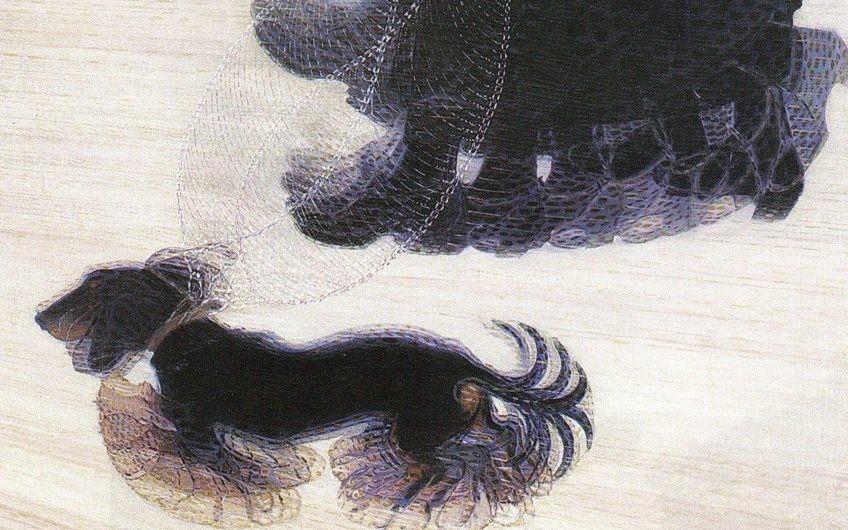
Implying movement is an integral method artists use to fully capture all elements of a
scene. It is not just the shapes and colour of the forms present, but also the overall atmosphere, elaborating on how different elements interact with one another within the space. Motion can be used by artists to highlight or contrast certain shapes and tones.
To conclude, there are many unique methods for artists to capture different aspects of movement. Capturing the motion of a scene leads to a more faithful interpretation of an environment, as a space is rarely lifeless and completely still. By including any small secondary adjustments, or a large motion that the piece is built around, recording movement as well as shape, and colours, will lead to a fuller and more true to life image. While there are several ways to add motion to an image, using multiples, smear frames, abstract decompositions of the direction of lines, shapes and textures, or the interaction of subjects within their environment; movement is a crucial part of any artist’s work, for even a lack of motion is intentional, as it defines the atmosphere of an image. Ultimately, the reason artists try and capture movement in their work is to make their pieces seem more three-dimensional and full of life rather than a static, two-dimensional representation of something organic that is ever changing.
An object’s position in the foreground and background can highlight its role within its surroundings.
33
Giacomo Balla



 Elise Millington: Working from Home (GCSE)
Tom Keohane: Food and Drink (A Level)
Robert Lewis: Expedition first aid (A Level)
Elise Millington: Working from Home (GCSE)
Tom Keohane: Food and Drink (A Level)
Robert Lewis: Expedition first aid (A Level)
34
Adam Wood: Wine storage table (A Level)





 Annabel Hewett: Working from home (GCSE)
Lara Toye: Inclusive Kitchen Aid (A Level)
Tom Steer: Coffee storage table (A Level)
Josh Done: Alfresco dining (A Level)
Frankie Powell: TV and Media unit (A Level)
Annabel Hewett: Working from home (GCSE)
Lara Toye: Inclusive Kitchen Aid (A Level)
Tom Steer: Coffee storage table (A Level)
Josh Done: Alfresco dining (A Level)
Frankie Powell: TV and Media unit (A Level)
35
Will Matthieson Alfresco: Entertaining (A Level)
To what extent were Hitler and Stalin similar?
Written in 35 minutes in test conditions
Fourth
Year
of cataclysmic proportions especially in the Ukraine, where more than 10 million people starved to death. Hitler had a similar horrific death toll, but he achieved it in a very different way. He scapegoated the Jewish people for Germany’s economic troubles and built death camps, such as Auschwitz to eliminate them. He killed more than 6 million Jews in a horrific genocide. Overall, Hitler and Stalin had more differences than similarities in terms of impact on the people. Although Stalin did cause the famine it was not as targeted as Hitler’s systematic annihilation of the Jewish people.
The 1930s saw the rise of two horrific dictators, Adolf Hitler and Joseph Stalin. Although they had vast differences in political beliefs, these dictators were hugely similar in the way they oppressed and controlled their citizens. There are three significant factors that link and separate these regimes. Ideological views, impact on the people and tools of repression. I believe that these dictators did share more similarities than differences through their tools of repression.
In ideological and political beliefs, Hitler and Stalin were starkly different. Stalin was a Communist. He stood for complete equality in all things. This included the abolition of private property and the control of businesses by the state. Communism eliminated the leadership of a single person and supposes that the state should be governed by the people. Hitler was the exact ideological opposite. His regime was fascist and capitalist. Fascism instigates an extreme social hierarchy where there is one clear leading party. In fascism, certain ethnic groups are made to rise above others. For Hitler this was the Aryan race, so called ‘pure blood’ Germans. Hitler encouraged privately owned businesses, buying huge amounts of goods and commodities from separately owned companies.
However, in reality Stalin’s regime was very different from the intangible utopia of communism. Much like Hitler, he created a strict social hierarchy, with himself at the top as supreme leader and minority groups such as the kulaks at the bottom. Hitler and Stalin were both authoritarian and totalitarian and they both made themselves a complete dictator of their country. Overall, Hitler and Stalin were more similar than different in their ideological views, as they both made themselves totalitarian dictators and Stalin did not follow through with the promised vision of communism at all.
Hitler and Stalin both had a highly significant impact on the people, but in very different ways. To fuel his dream of turning Russia into a modern military and industrial superpower, Stalin ordered all farmers in agricultural areas into state owned collective farms to increase that efficiency and production rate. However, these farms failed, producing 60% less food than expected. Instead of leaving this pittance to the peasants who formed it, he seized the food and gave it to the cities instead to fuel the rapid industrialization. This caused a famine (known as the Holodomor),
The factor in which Hitler and Stalin were most similar were in their tools of repression. In fact, this is almost universal to all dictators. They both controlled the population through a mixture of terror and propaganda. For example, Hitler and Stalin both controlled the media to portray themselves as benevolent gods, and therefore the ultimate leaders. They both used a network of both secret police (Gestapo and NKVD) to send any dissenters or political opponents to prison camps, or even execution. Any potential threats to their power were swiftly eliminated and people were too scared to try and revolt against their rule.
In conclusion, Stalin and Hitler share more similarities and differences. Although theoretically they had deeply opposing political views, in practise Stalin and Hitler both ruled the same way - terror. They used propaganda to sway public opinion, while eliminating political opponents and dissenters. Both dictators had a devastating impact on human life through both the Holodomor and the Holocaust. They have the inevitable factor the links all dictatorsrule through extreme terror and a horrific disregard for human life.
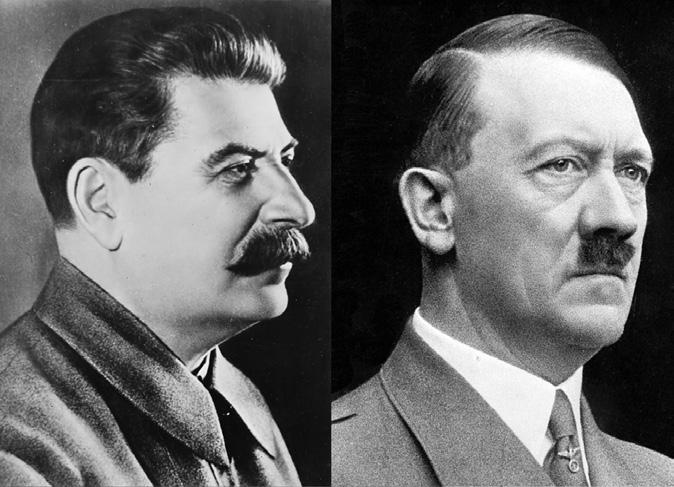
Josh Taylor
[S]talin ordered all farmers in agricultural areas into state owned collective farms.
36
Marriage is an outdated concept
This unseen, timed essay was written in one hour
Rosalind Mitchell
One can argue that in the year 2022, marriage is indeed an outdated concept. In the modern world, the old need for stability and unification that marriage provided in the eyes of the law is no longer such a necessity. However, it cannot be denied that many people still personally desire the traditional wedding and marriage.
For some, marriage is a show of permanent commitment. People desire physical evidence (i.e. a wedding band or a marriage certificate) to achieve a sense of security within the relationship. Furthermore, many people still want the traditional ‘big day’ of getting married followed by a union until death. It is understandable to want that stability and show of love. Moreover, some people view a marriage as providing a sturdy and stable environment in which to raise children. However, one must also consider the effects of separation or divorce on the children and the people within the marriage. A divorce can be detrimental on a child’s mental health, especially a volatile separation and the cost of one can impact both partners severely - on average, UK couples spend ~£14,000. Furthermore, whilst marriage is perceived as a show of commitment, it cannot be denied that cheating still occurs in monogamous marriages. Therefore, this could suggest that a marriage does not automatically ensure a faithful or healthy relationship.
Additionally, the idea of marriages being reliable is somewhat baseless. 42% of marriages result in a divorce as of 2020. This suggests a fundamental problem within marriages and furthermore, it raises the question of whether a marriage is still a necessity or not. Not to mention that weddings (and, by extension, marriages) are expensive – an average of £25,000 is spent per wedding. People are also able to feel safe within a relationship even without a marriage, showing that they are not especially needed. Conversely, marriage also provides other legal benefits – such as visas – which are still desired within our society. Therefore, whilst marriages seem
to statistically lean towards failing, there are still privileges that it provides which could be considered vital.
Another reason to get married would be religious beliefs. Within all major religions (such as Islam, Christianity and Judaism) marriage is perceived as incredibly important. For example, certain sects in Christianity have marriage as a sacrament and therefore partaking in a wedding/ marriage is an act of faith. One cannot deny the importance of religion around the globe, around 80% globally identify with a religion. Yet, a substantial portion of the world do not share in these beliefs, and one cannot force them into doing so. This suggests that while a major part of the world still considers marriage an integral part of life, not everyone does and so could personally consider it an outdated concept.
Some may argue that marriage should be left in the past due to the hassle it brings. It can be difficult to manage and adapt to what may be seen as a new way of life. Many couples, when they marry, merge bank accounts and assets. The reason for this is mainly due to personal preference or, unfortunately, social stigmas – it is expected to share everything and partially sacrifice independence. This can be an arduous task and can put pressure onto
the new marriage, which poses a question as to whether it is worth getting married knowing this is in your future. Yet, managing finances is not impossible and cannot be attributed to making marriages outdated, rather only more complex.

Another aspect of society must be considered. The LGBTQIA+ community has only just gained the right to get married in the last two decades. It began with The Netherlands in 2001, and here in England, the right of same-sex marriage was only gained in 2014. Even currently, many countries still fight for it to become legal. One might consider it cruel to say marriage is an outdated concept while many still do not have the right to it.
Marriage was originally meant to unify two people to allow wives to be taken care of and to reproduce in a socially acceptable and secure way. Now, those views are outdated but the pressure from society to marry, and by a certain age, still remains. It is not marriage itself that can be viewed as an outdated concept, but rather the expectation and the stigma of being unmarried.
In conclusion, I believe that marriage should be your own choice. It should not be a patriarchal society enforcing it, but your own faith that your relationship is strong enough and your desire to be married. It is not the act of being married that is behind the times but, in turn, certain aspects and beliefs that are.
[T]he pressure from society to marry, and by a certain age, still remains.
37
Lower Sixth
Are politicians dishonest or can we trust them?
Josh Wild
Lower Sixth
Over the past few years, the world has been graced with some poor leaders, who have misled the public through dishonest tendencies. From Trump to Johnson and from Bolsonaro to Putin, across the entire world, political leadership has not earned the trust of the public. The dishonesty ranges from lying about illegal parties and denying election results, to waging an illegal war and denying the dangers of COVID. The media has feasted upon this dishonesty, which alienates the public from politics. Yet, despite the norm of constant dishonesty from the world’s most important leaders, there are some who show nothing but dignity and provide hope that a new era of politics, where the leadership can be trusted, can be ushered in.
Starting at home with our government, the current Conservative MPs have shown little evidence of honesty during this parliamentary term. The former Prime Minister Boris Johnson, whose driving passion in life seemed to be to mislead the public, was a model of dishonesty. The disgraced former PM found great enjoyment in partying through the Coronavirus lockdown, breaking the laws which he himself set. Not only did he break the law, but he also did his very best to cover up the Partygate scandal and attempted to battle on and remain as PM before eventually being forced to resign. His dishonesty plagued his government’s attempts to guide the country through its trickiest moments since WWII, and his sheer disregard for the rules set a poor example for the country to follow. With a more trustworthy and effective leader, could more have been done to prevent the spread of COVID which made people’s lives miserable for two years? Could more have been done diplomatically to prevent Russia’s illegal invasion of Ukraine? And could more have been done to relieve the pain caused by cost-of-living crisis with more trustworthy and stable leadership? The answer to all three questions is yes.
However, it must be said that not all the dishonesty within the Conservative government comes from Boris Johnson. The former Home Secretary Priti Patel

was found to have been bullying her staff, and nothing was done. The current Home Secretary Suella Braverman, who was briefly the former Home Secretary for just six days, was reappointed after compromising national security. Since reappointment she has kept up her dishonest streak by describing a “swarm of migrants”, despite warnings against this derogatory terminology by Holocaust survivors. The job is clearly cursed. The former Health Secretary, and reality TV star, Matt Hancock, was forced to resign in the middle of the COVID pandemic after it emerged that he had an affair (many Twitter users have questioned why anyone would want to have an affair with Matt Hancock, but that is beside the point!). The current Deputy PM Dominic Raab has been placed under investigation after a wave of civil servants accused him of bullying. The former Tory Party Chairman Nadhim Zahawi was humiliated and fired after it transpired that he owed HMRC £3.7 Million in tax, despite these allegations being known at the time of his appointment. These examples show a pandemic of sleaze that has gone through the Conservative party under the watch of Johnson, much like the Coronavirus swept through Britain on his watch. The dishonesty in politics exists on both sides of the aisle, for example former Labour leader Jeremy Corbyn lied about the extent of antisemitism in the Labour party under his leadership and has since been suspended from the parliamentary party, making many
within his own party and the public distrust him. This shows that British politics has been taken over by a culture of dishonesty, which alienates the public, causing them to cease engaging in politics.
The 45th US President, Donald Trump, presided over a government rotting with lies. I toyed with not including him in this essay as I do not like to view him as a politician. Instead, I like to view him as a bleach salesperson after he increased their sales by instructing his citizens to drink it as it would cleanse them from COVID. Trump’s leadership did not inspire trust, as he frequently lied on national TV and was prone to having constant strops on Twitter, which is not something usually associated with statesmanship. Trump was dishonest about things big and small during his Presidency, from getting into Twitter arguments over calling the CEO of Apple, Tim Cook, “Tim Apple,” to denying dangers of the Coronavirus and refusing to accept the legitimate 2020 election results. This dishonesty had catastrophic consequences. On 6 January 2021, Trump played a part in inciting a riot from his supporters who marched on the Capitol Building in protest of the results. This damaged the symbol of US democracy and led to five people losing their lives. This clearly shows the danger of politicians being dishonest and not being trustworthy, as leaders have to lead their countries by example. Since Trump left office, with all the grace of a bull in a china shop, he has taken to squabbling with the FBI. He refused to give up classified documents being kept at his house, so it was raided, and along with recovering some documents, they found evidence of
[H]e frequently lied on national TV and was prone to having constant strops on Twitter.
38
Boris Johnson breaching lockdown rules
documents being hidden via being flushed down the toilet - where Trump’s entire Presidency belongs. Trump never gained the trust of his people, and since his Presidency America is more divided than ever, showing the damage that a dishonest politician can cause.
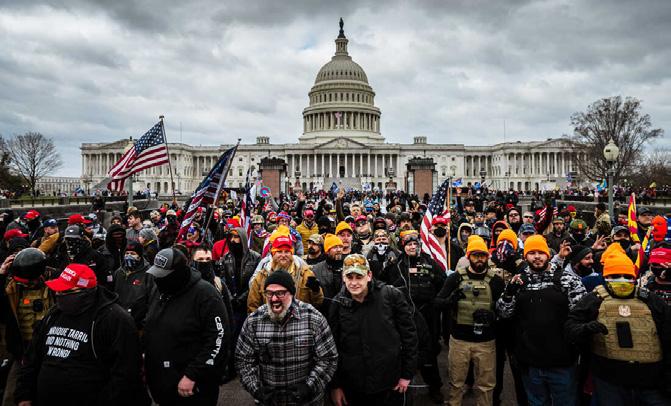
After the chaos of the Trump years, many US citizens felt Joe Biden would be a breath of fresh air. But were they right?
Biden, although immensely qualified, has had his credibility doubted since his election. People question whether they should trust a man of his age, and his gaffeprone nature makes many question whether he is up to the job. He has continued the Trump administration’s tradition of possessing classified documents when he
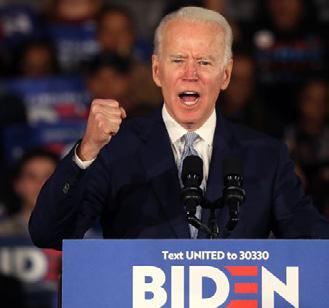
with grace, providing Ukraine with crucial support, committing $27.4 billion dollars of security assistance to Ukraine. He also has fought hard against Republican opposition to abortion and has passed equalities legislation, which helps him earn the trust of much of the electorate. Whilst Biden has not got the trust of all US citizens, he has been honest whilst he has occupied the most powerful office in the world, which shows that politicians can be honest in the 21st Century and, whilst they might not get it, deserve the trust of the public.
that he was horrendously unqualified for the job, but his leadership has been up to scratch. He has led by example, not fleeing Kyiv when it was besieged to stay with his people, and his videos from the war-torn streets have been inspirational for people across the whole world. His bravery in facing down the enormous Russian threat has been commendable, and his diplomatic skills on foreign policy have been pitch perfect. His brilliant speeches from the House of Representatives in the US (the first major address to Congress from a foreign leader since Churchill in 1941) and Parliament have illustrated why Ukraine needs continued support with raw honesty about its situation. The world now trusts this man, who until last year (unless you are a Paddington mega fan) no one had heard of. To have a politician on a global scale who utilises honesty and is trustworthy is refreshing and shows that great leaders still have a place in the 21st Century. But, sadly, honest and trustworthy politicians are few and far between these days.
should not, although unlike Trump, Biden has cooperated with the Justice Department and the FBI. Also, his response to the Taliban regaining control in Afghanistan following the disastrous US troop evacuation was bizarre, as he hid from the public eye, only giving one minor address during the crisis. These issues do not make him dishonest but do add to the distrust the public feels for him. Biden is working to gain the trust of the public though, viewing it as critical for his political success. He has handled the Russian invasion of Ukraine
No politician is more dishonest than Vladimir Putin. His constant lies and deceit have taken the world to the brink of WWIII, showing the danger of immoral and dishonest politicians. His lies depicting his illegal war as a saviour mission have led to thousands of innocent civilians and soldiers dying, and the global tension between Russia and the West increasing. Fortunately, the majority of countries have seen through his web of lies and have come to Ukraine’s aid. His dishonesty has united countries from around the world, giving them a common goal- to defeat Russia. His dishonesty has led to the world becoming a far more dangerous place, as people realise that Putin, a man in control of a nuclear arsenal, cannot be trusted.
On the flip side, the one beacon of light to come from the illegal Russian invasion of Ukraine has been President Volodymyr Zelenskyy. The former comedian and voice of the Ukrainian version of Paddington Bear has found himself leading Ukraine into battle against Russia, which has the potential to escalate into WWIII. Based upon his prior credentials one may think
It is a sad state of affairs that politicians, for the most part, are neither honest nor trustworthy. Whilst there are a few examples of politicians who are refreshingly honest, the majority could not be described that way. This is a shame, as the world is full of good people who each day try to make positive change, but these people are not ascending to leadership roles. Many claim, like PM Rishi Sunak, that they will end the era of sleaze and dishonesty, but their claims are futile. To make real change politicians need to be like Zelenskyy, and stand up and help their countries, but most are corrupted by the power that they wield. Perhaps politicians should strive to be more like Zelenskyy’s fictional alter ego Paddington, who gained people’s trust via his kindhearted nature, solving people’s problems and “[looking] for the good in all of us”. If politicians in power were like that, then maybe they would finally do some good.
 The January 6th insurrection
President Biden on the campaign trail
Zelenskyy’s character, Paddington Bear
The January 6th insurrection
President Biden on the campaign trail
Zelenskyy’s character, Paddington Bear
39
[T]he one beacon of light to come from the illegal Russian invasion of Ukraine has been President Volodymyr Zelenskyy.
How have artists used line within sculpture?
Natalia Schmitt
Upper Sixth
I have chosen to explore how line has been used in sculpture as I’m interested in the shapes created by artists in this form as a way to express their emotions through line. I would also like to expand on the materials various artists have used to create shape and form. I will explore artistic elements such as depth, thickness and fluidity of lines artists use, as well as, the style, impression and mark making created and explored through experiments and exhibitions.
Line has always been used in art history, but when we use these traditionally twodimensional lines, we transform them into a multitude of different sculptures which stem from the same original method. I’m keen to delve into the work of Naum Gabo and his curved structures, such as, Spiral Theme and Linear Construction in Space, which explore interlocking lines and shapes, as well as looking into the work of Chenhung Chen and her adaptation of the idea of line and her use of the surrounding environment. What I have found in many of the sculptures is that their use of space and environment has been very successful.
Historically, the use of lines in art goes back to cave drawings and mark making on rocks, using materials they had at the time. This very two-dimensional way of creating has since developed, especially in the 20th Century when artists started to experiment with the use of different materials such as metals, wood, string and wool.
A more contemporary approach to this is the artist Naum Gabo, some examples of the materials he used within his sculptures are nylon and plastic. A big piece and something with a lot of success is Linear Construction in Space
No. 1 because it shows the harmony and connection of the lines and the organic rhythm generated by this composition. The key aspect of his work is how intricate the lines are and the thread because the structure appears very strong and has lots of little interconnected lines which is something quite beautiful for the viewer. I believe that Gabo uses line to create a different
composition exploring form and shape, depending on the angle the viewer sees it. “[The Constructive idea… ] has revealed a universal law that the elements of a visual art such as lines, colours, shapes, possess their own forces of expression independent of any association with the external aspects of the world… they are not merely abstract signs, but they are immediately and organically bound up with human emotions”.
An artist that was, in part, inspired by Gabo is Barbara Hepworth, as we can see similarities in their use of lines and form and how they combined the two to create their sculptures. With the work of Hepworth, it appears almost like a battle for control, or the line has been used to connect two ends of the piece as a way of holding the sculpture together. She described the string as a “pull she felt in her body towards a landscape, so there’s a very physical sense of being held together”. The key word being “held”, almost as if the lines are constricting the shapes of the sculptural forms. Her sculpture Winged Figure portrays a set of lines seemingly holding, molding and bending the shape behind to form this piece of work.
As lines are something we see all around us, many artists have used these curves and shapes to create pieces of art as an extension of the environment. An example of this method is Andy Goldsworthy. By watching the documentary Rivers and Tides I was able to view his work in a different way as you are able to see his sculptures come together and the process of creating he goes through. His way of speaking about nature and his respect for it, are portrayed through his outcomes as he says, “it’s best the wall is a line that is in symphony with the place through which it travels”, this description of the movement this line must take shows the balance between it and the surrounding environment. It’s fascinating how he explores the land which he walks through and then reflects these curves and movements within his sculptures. His artwork of the ice curves attached to rocks
and the trail of leaves flowing through the river is a demonstration of his collaboration between nature and line. Not all his work is a portrayal of interconnected line, but his work features aspects of interconnection between humans, nature and sculpture.
Through interconnected lines we can break boundaries and perceptions of space and form. Antony Gormley uses steel structures to create his sculptures and his method of representing the human body through these combinations of metal lines. He explores the relationship between the human form and space through his sculpture Quantum Cloud, an instability in the elements, a fight for power. The Domains portrays a series of sculptures made from casting volunteers and then within the moulds he welded steel elements to form this collection of interconnecting lines. The use of this material and shape is interesting as the dynamic of the sharp edges and corners of the joined metal illustrates a contrast to the human body itself (traditionally a smooth and curved form), as well as steel being an unnatural material representing

[I]t’s an exaggeration of ideas and feelings expanding across the room.
40
Entelechy #21 by Chenhung Chen
a naturally made figure (the human body).
“The Domains allowed me to evoke the internal space of the body as a field, but are still bound by an invisible skin: I wanted to extend or ignore the skin”. This idea of breaking free of the traditional human form shape is an interesting way of expressing an emotion, almost as an explosion of cells and organs gathering. The symbolism of cells and neutrons demonstrates this idea that we are deeper than our skin and what lies beneath is a lot more interesting.
Another example of an artist that looks at the extension of line as well as using the negative space as an aspect to their art is Cornelia Parker, especially in her casting of pavements. These castings show the connecting lines between paving stones as a sculpture, instead of focusing on the stone it’s interesting she decided to use the course in between. These castings aimed to show her childhood fear of stepping on the lines of the pavements. The emptiness to these lines and the lack of detail, as it’s just the lines and shapes, portray an ominous and empty feeling within her outcomes which successfully shows her aim for this series of work.
These artists have mainly used sharp, angular and cornered lines, but lines are more than this, they include a fluidity and effortless curves within a space. Sheela Gowda uses thread to create a variety of suspended pieces covering a space, for example, And Tell Him of My Pain, which is an encapsulating image of intertwining thread that’s is spread and cascading across the whole room. This blood red coloured thread that was binded together by pigment and glue shows a softness and fluidity within the room as it swims across the space and hangs from the ceiling.
This sculpture demonstrates a display of sharpness by colour, but a smoothness by the movement of the lines, and this contrast shows an interesting mix between the two elements. This artwork also shows a pain, a struggle, untying knots and bending, overcoming areas and adapting across the surfaces which could symbolize the internal struggle.
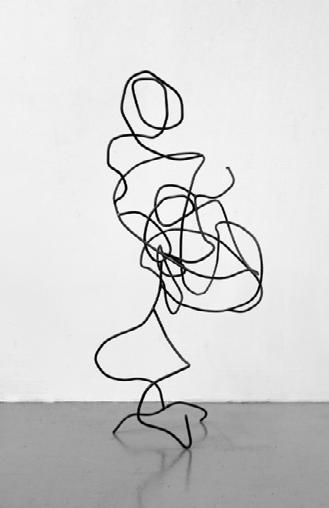
Following on from Gowda, an artist who shows this fluidity and stance of interconnectedness within their art is Chenhung Chen, who uses recycled materials, such as copper and electrical wire and other objects in this field. She first found the importance and power of lines within Chinese painting and calligraphy, as well as in American Abstract Expressionism. Her way of thinking and words help me understand her work: “Through the use of line, I am able to express feelings of delicacy, power, buoyancy, strength and constant motion. The linear qualities inherent in nature also inform my assemblage process and creative vision”. Chen has used the space to expand
her linear sculptures across the room or even to use a singular spot to allow the wire (and other materials) to cascade down, almost like a leaking tap creating a puddle on the ground [Entelechy #21] . Chen states: “My art is about dichotomy: Concord and dissonance, stillness and chaos, the subtle and the powerful, the bound and the boundless. From this are formed works dealing with balance, the making of the invisible into the visible, and the driving force for inner fulfilment”. This strikingly contrasting list to describe her art is how the balance is formed within her work and how the drawings become reality through this constant battle a successful mix of ideas, lines and materials.
Battles come in many forms and this concept is explored widely throughout the artistic world. One form of a battle is verbal, such as an argument. One example of this is the spatial sculpture by the married couple Birte Bosse and Thomas Rentmeister, whose installation is a portrayal of their artistic cooperation showcasing a passionate argument
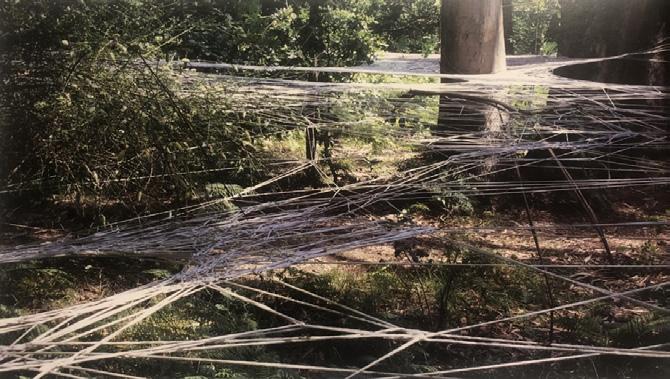
 The Domains by Antony Gormley
Louise by Birte Bosse
The Domains by Antony Gormley
Louise by Birte Bosse
41
untitled by Fernanda Gomes
between the two. They used steel and paper to create this explosion of line and shape. This visual representation of an argument creates a feeling of ups and downs with the lines bouncing across the room leaving leftover paper scattered in piles across the room, almost like remains. Argument communicates emotions such as freedom, expression, anger, passion conveying the pure roots of an argument the channels of anger and wanting to break free, a conflict needing to be resolved and calmed down. That’s what this sculpture does, it’s an exaggeration of ideas and feelings expanding across the room. Through the individual work of Bosse, I saw a continuous use of line and metallic work. Her piece Der Zauberlehrling made of oxidized steel reminded me of the work of Chen, however, instead of the fluidity being the main focus in Bosse’s work it felt like a more structured and fixed cascade of lines. In some of her other work such as Louise and Kleeopatra there lies a “constant ebb and flow and various intersections coalesce to materialize the state of being in process” through the use of line and shows the contrasting ideas she has through the use of line portrayed by the different effects.
In contrast to the chaos of Argument, is the stretched string work of Fernanda Gomes, where she has incorporated the string into nature and connected them together. This thin layer expands the lines within nature: roots of a tree, spider’s web, lines within leaves. I find the use of a singular material a standpoint and contrast of the busy nature and chaos surrounding it. It’s almost like a sea or lake covering what’s below but allowing the viewer to see glimpses: an underground escape, another layer of earth, a balance of calm and erratic. This great expanse of pattern and shapes shows a clear exploration of the string adapting and spreading across trees and nature.
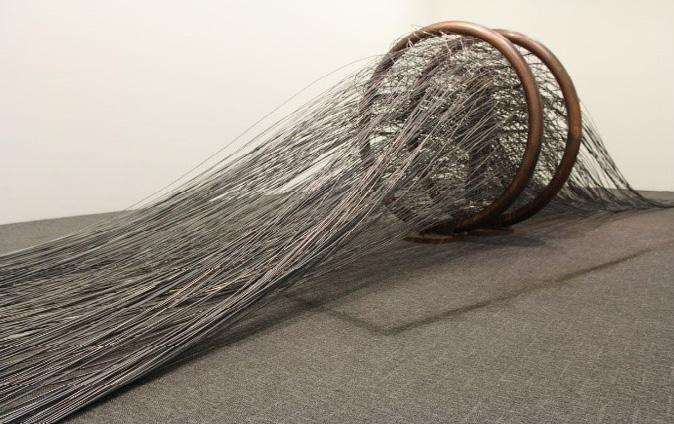

Jose Resende’s work is a great example of Brazilian contemporary sculpture. He finds materials, generally “present in the daily routine of urban life”, he then constructs and transforms them into these various shapes and forms. He describes his work as “constructions that require a large repertoire of even materials”. Although I wasn’t able to find specific details on this sculpture of his, through observation is appears he has used industrial materials to create it, use of steel wire rope, and allowing it to change and weather to the natural elements. I find this idea of allowing a sculpture to adapt at the hands of nature a very effective way to allow the natural elements play a part in the construction of a piece. Although
the sculpture appears very industrial, the fluid linear wire draping from this central circular sculpture allows for this contrast between the fluid and free lines to the thick piece in the centre that holds it together. At its centre the sculpture has two metal rings which constricts the overall shape, and the pull of metal wires either side makes it seem as if it is moulding and melting into the floor, and this presents a very satisfying connection of spaces.
To conclude, I have chosen a variety of artists from around the world and the different ways they have used multiple lines within their work. As well as how they have incorporated different materials to represent lines that intertwine with each other. My interest in these sculptures and artists developed as I explored the way these artists used lines through sculpture. The various use of materials portrayed the vast depth of range artists have created through this use of line, starting with Gabo and Hepworth, who used line to construct
forms and also to connect lines to shapes. In a way this can be linked to how Gormley used metal structures to form figures, a shape made from many lines, almost hollow. This idea of hollowness was also demonstrated in the work of Parker who used lines to cast the outline of pavements. The main difference I found within this collection of artists was whether they used line as a form of fluidity or as a way to portray stiffness and a more structural route. Gowda, Chen and Bosse have all used lines as a method of showing a fluid state, almost in motion to encapsulate the feelings within their pieces. The techniques that Golsdworthy, Gomes and Resende used to collaborate with nature and apply natural elements that would not just aid but also help conclude their work as successful. In summary, these artists have shown how to express themselves through the use of these linear sculptures and what I appreciated was how they used the environment, space and the composition of these lines to create these outcomes.
 untitled by Jose Resende
And Tell Him Of My Pain by Sheela Gowda
untitled by Jose Resende
And Tell Him Of My Pain by Sheela Gowda
42
Linear Construction in Space No. 1 by Naum Gabo
Must we always obey the law?
Joel Ireland
Socrates stated, “If I have constrained my freedom to be bound by the law, under the premise that others will do likewise, then it’s unfair if you choose to disobey the law whenever it inconveniences you” (University of Sydney, 2017). If one only followed laws that one found appropriate, then one would be living in an unfeasible society based upon personal autonomy. This suggests everyone has a moral obligation to obey the law. If some endure impracticalities as a result of obeying it, why should others disobey law when it inconveniences them?
Socrates, (470-399BC) one of the most intellectual philosophers, discovered 2,500 years ago that positive law and justice do not always coincide (History, 2019). In Plato’s and Xenophon’s ‘Socratic’ dialogues, Socrates was always obedient to the law of Athens (Law Explorer, 2015). This was displayed in his accepting the court’s guilty verdict and condemnation to death (Law Explorer, 2015). Socrates believed that humans should never act unjustly. If one followed a moral compass, then this principle should have been executed autonomously. However, if Socrates never committed injustices, then the legal system which condemned him could not have been entirely just. This implies that justice and the law do not always correspond with each other, presenting us with the paradox that morally, we must be just and equally obey the law, yet there is a possibility that the law itself is unjust. It can be deduced that acting in a just manner is not attainable without breaking an unjust law. The distinction between conforming to a country’s legislation and following a righteous moral compass is not always evident. These events can however be concurrent and when they are not, one has a choice: obey an unjust law or follow conscience and accept the consequence.
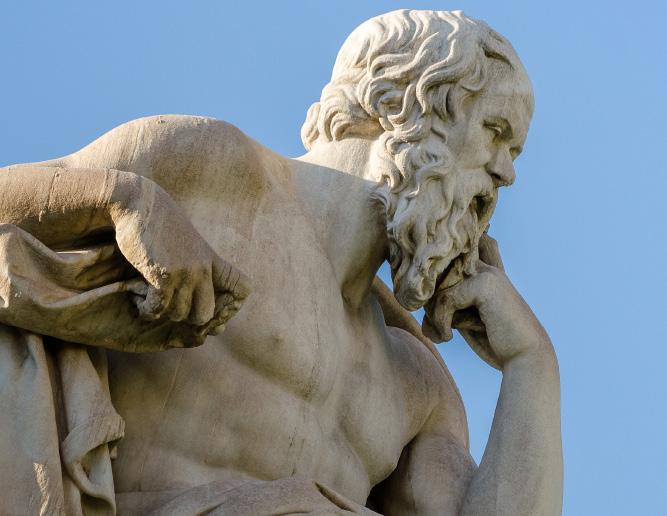
We need to define what is meant by the question this essay poses, ‘Must we always
obey the law?’. We can define the ‘law’ as a set of governing principles fabricated and enforced by a state government; this essay will mainly refer to His Majesty’s Government, explicitly the Government of the United Kingdom, but will consider worldwide scenarios. ‘Always’ means every law enacted by the government is obeyed, not just complied with. Obeying the law means that a person must act with some recognition that they are doing an activity that the law demands (Sevel, 2018).
The law must always be obeyed because of our moral obligation to obey it. It is sometimes termed political obligation, which is a moral requirement to obey the law. The idea that a law is a law is reason enough to obey it, regardless of what that law addresses, for example a social or an environmental law (Klosko, 2020).
Similarly, we must obey the law out of fairness. If we “simply opt out of every law we disagree with, civil society would quickly become very uncivil”. (University of Sydney, 2017). In one of Plato’s dialogues,
Laws also protect our rights as citizens. They give us the right to a fair trial, to vote and freedom to express ourselves. Without laws, these rights would not exist (The Davis Graduate, 2022). Why should it be justifiable to defy these laws which protect our fundamental rights? Furthermore, laws protect our general safety. An especially significant law is the Human Rights Act of 1998. Its sole purpose is to be a guardian of our freedom and rights. Article 10 – Freedom of Expression underlines that “this right shall include freedom to hold opinions and to receive and impart information and ideas without interference by public authority and regardless of frontiers”. Furthermore, Article 2 - Right to Life, states “Everyone’s right to life shall be protected by law”. In most cases, laws are designed to maintain personal liberties and act in the best interests of society (The National Archives, 2023).
Additionally, the law should always be obeyed because the cost of maintaining law and order is extortionate. His Majesty’s Government Departmental Expenditure Limits in 2020-2021 amount to £26 billion, a mammoth budget required to maintain law and order. However, in reality public expenditure amounted to £39.1 billion. Comparatively, the amount spent on environmental protection, housing, community amenities, recreation, culture, and religion totalled £39.6 billion. If one always obeyed the law, then the government
The distinction between conforming to a country’s legislation and following a righteous moral compass is not always evident.
Lower Sixth
43
Socrates - A renowned Greek philosopher who is credited as the founder of Western philosophy
would not need such an extensive budget. Furthermore, money could be invested in sectors such as the National Health Service benefiting the whole society. Crimes such as shoplifting have an enormous impact on both small and large businesses. In 2019 crime cost retail £4.2 billion. In the absence of crime, Britain would experience more growth in various sectors (Centre for Retail Research, 2019) (UK Government, 2022). However, even if we could remove crime, society would still need law enforcement officers to provide aid in emergencies.
In a democratic society, citizens have a right to express their views. If laws are made which do not conform with their ideal social, economic, environmental and political principles, an alternative is to resort to civil disobedience. Whilst certain individuals think that civil disobedience can sometimes be legitimate under a despotic regime, civil disobedience should not be justified in a democratic society. A democratic society provides its members with legal instruments for the redress of their grievances and so it
should be unnecessary to resort to civil disobedience. This suggests that the law should be followed, because if we have an influence over it, there should be no reason to disobey it. Hypothetically, the law should always be obeyed if it is what we manifested. However, no democracy is completely infallible. As evident in times of economic turbulence, individuals put their survival over democratic principles. Even in a democracy not everyone is satisfied with the elected government. Therefore, it cannot be true that all laws are fabricated regarding everyone’s best interests.
In some cases, laws can be unconstitutional and unjust. It is said that one has not only a legal but a moral responsibility to obey just laws. On the other hand, one has a moral responsibility to disobey unjust laws (JFK Library, 2023). Prominently in 1950-1960s America, Martin Luther King Jr, advocated that any law which uplifts human personality is just and that any
law which degrades human personality is unjust. He suggested that one has a moral responsibility to disobey unjust laws. He argued that an unjust law is an unfair principle imposed upon a minority or in some cases the whole of society, which itself had no part in enacting because they did not have the right to vote. Throughout Alabama, all types of propitious methods were used to prohibit minorities from becoming registered voters. Therefore, it is not possible to say that the Alabama legislature which set up segregation laws was democratically elected. This was the case for countless Americans until the Civil Rights Act of 1964 and the Voting Rights Act of 1965 were enacted by Congress (US Department of Labor, 2023). Thus, if it is our duty to disobey an unjust law that is either created unconstitutionally or distributes the idea of inferiority between members of society, then our moral standard permits us to break these laws.

“[W]here-ever law ends, tyranny begins”.
44
Historical activist Martin Luther King Jr
If respect and candour are good reasons to obey laws, then when there is a violation of the same principles it provides a good reason not to obey them. A law that contradicts fundamental human rights and serves no benefit to society should not be unacceptable to disobey. Currently in Cambodia authorities are using the judicial system to arrest, prosecute and imprison human rights defenders. Without defiance of these unfair principles, human rights in such countries will not progress (University of Basel, 2021) (Amnesty International, 2021).
One principal reason for not always obeying the law is to prevent greater harm than the law is intended to protect. Imagine a scenario where a doctor has to speed to an emergency. He saves a life, but receives a speeding fine. It should not

be fair that he suffers the consequence even when saving a life. If we have a moral obligation to help in an emergency, it should be the case that we have a temporary exemption from the law.
To conclude, it is clear society needs a system of rules to govern itself. These laws secure our cardinal human rights, guard our rights as citizens and form guidance of acceptable conduct. However, it seems impossible for an individual to always obey every law. This is because a law can be unjust, giving us reason to disobey it as we have a moral responsibility to defy unjust laws. If we are posed with a dilemma of either respecting our moral conscience or obeying the law, we might be compelled to choose the prior option. We should all aim to follow the law out of a principle
of fairness and what the laws themselves intend to do. However, laws are designed by humans, we are not perfect, therefore we can deduce that laws are not perfect. It is incorrect to say all laws are just, this permits our moral obligation to advocate for change. It seems plausible that if we were to always obey the law, we would no longer need a network of governing rules to support society. Ostensibly, if the utopia of a law-abiding civilisation is reached, having removed laws, then society should remain stable. In an idyllic society, we shall not need laws, for in theory, we shall do what is morally correct, which is what the law intends to do. However, it is accepted that some laws contrast what is morally correct so this statement cannot be entirely true. Furthermore, human nature has a propensity for violence, aggression and tyrannical behaviour and so this aforesaid utopia is a hypothetical fallacy. John Locke, an English philosopher stated that, “Where-ever law ends, tyranny begins”. (Online Library of Liberty, 2023). This is an accurate description of what would occur if our complex system of laws disappeared.
The Royal Courts of Justice
45
The distinction between conforming to a country’s legislation and following a righteous moral compass is not always evident.
Oh my goodness, I hate spiders
Orion O’Connor
Upper Sixth
venomous spiders have a bite described as ‘unpleasant’). Yet because there is no stimulus encouraging humans to evolve out of arachnophobia, we are left with it in our awkward, bug-fearing selves… This is an issue.

Because we’ve remained arachnophobic in a situation where we don’t need to be, we’ve given spiders a stimulus to evolve around.
When you see a spider in your house, what do you do?
Flush it down the toilet, right?
If you answered yes, you’ve helped progress the evolution of spiders.
Among the fears of flying (aerophobia) and heights (acrophobia), arachnophobia (a fear of spiders) is the third most common phobia on the planet, an estimated 720,000,000 (that’s right, million) people have some form of arachnophobia. Although we define a ‘phobia’ as an irrational fear of something, whether it’s an action, set of objects or even long words (Google ‘Hippopotomonstrosesquippedaliophobia’), some phobias are genetic adaptations that have been evolved to get you out of danger.
Our genome, which is the complete set of genes every human being has, shows genetic variation between each person. This variation is due to our different ‘alleles’ for each gene that we have. In A Level Biology, we are taught that a gene is a section of coding DNA that codes for a particular protein. These proteins have a wide range of uses, from growth and repair to hormones in the endocrine system, and each different allele is a different form of the same gene which produces a different protein, so for the same gene in two different people, they each can have a different allele which will produce a different protein when transcribed, and ultimately have a different effect on the body.
Phobias are a behavioural adaptation evolved through directional selection, where a random mutation in our genome produces an allele which makes an individual produce a cocktail of cortisol and adrenaline (the two hormones involved in the sensation of fear) when we encounter a particular stimulus.
In directional selection, new mutations that give animals (and us) more success at surviving, and hence, reproducing, are more likely to be passed on, so after many reproductive cycles, the advantageous allele is a lot more common in the population (higher allele frequency).
A really good example of this is the evolution of the arachnophobic mutation. Before humans were living in towns and cities and in areas where there was significant risk of being bitten by a venomous spider, it was an advantage to recognise a spider as a threat to your life and thus, run screaming.
However, as we’ve developed as a society and have moved into houses, away from areas with dangerous predators, there’s been less of a need to ‘freak out’ when we see a tiny spider scuttling across the kitchen floor (even less so in the UK as our top three most
Because of our tendency to kill any spiders we see in our house we are removing the population of spiders which are willing to show themselves to us. This means we are effectively removing the alleles from the population which cause this behaviour for spiders to come out of their hidey-holes. This means we are effectively breeding smarter, sneakier and more recluse spiders that we won’t see until it’s too late.
Another really good example of us helping progress the evolution of other species that may come back to bite us is the overprescription of antibiotics. In many cases documented by the WHO, antibiotics are prescribed when not needed. This places bacteria in an environment in which only the bacteria which have evolved the allele for resistance to the specific antibiotic survive, increasing the allele’s presence in the population tenfold. This makes the proportion of bacteria in the population resistant to antibiotics much higher.
Despite the fact that we may never see this evolution in practice in spiders because of the extraordinary time it takes for organisms to evolve, I think this situation emphasises the need for humanity to not only consider our direct effects on the ecosystem around us, but to think about what impacts we might have on the development of these species with which we share the Earth. Who knows, maybe the spider you didn’t see earlier today could be crawling under your bed right now...
46
[W]e are effectively breeding smarter, sneakier and more recluse spiders that we won’t see until it’s too late.
What are the environmental costs of current consumer trends, behaviours and purchasing decisions?
The environmental cost of online purchase returns

In recent years online shopping has boomed. The extensive level of choice and ability to shop from unlimited stores in the comfort of a living room has shifted consumption away from the high street and onto the internet. Although online shopping may seem like a blessing for consumers, it brings with it a range of negative environmental externalities.
Shift in consumer habits has also contributed to a rise in returns. ‘Bracketing’ is a growing consumer habit, where consumers purchase multiple variants of the same item to eliminate the risk of online purchasing. Firms then expect an increase in sales, as there is a higher probability consumer will keep at least one of the items. But do consumers know what happens to their returned items?
A study completed in 2019, found that 90% of consumers believe returns are simply re-stocked. However, in fact 25% of returns are deemed unsuitable for re-stocking, whilst the other 75% must be transported to various locations to be processed, before being restocked.
A major environmental cost of online purchase returns is the increase in carbon dioxide emissions. Soaring increases in free returns has meant firms must use reverse logistics, moving the returned items from consumer back to the retailer – often through various locations. As a result of online returns, 27milllion metric tons of CO2 were emitted in 2021, the equivalent of 5.9 million cars driven in one year. The danger of increasing CO2 levels is the effect it has on the climate. CO2 contributes to the enhanced greenhouse gas effect which in turn results in sea level rise, loss of wildlife, record heatwaves and more frequent and severe natural disasters. It cannot be said that online purchase returns are the cause of all these problems, however, it is imperative that we recognise the growth in ecommerce and free returns does have a devastating impact on the environment and one that is only going to become more prevalent if we don’t act soon.
In 2021, Optoro, an online returns processor, estimated the cost of possessing a return would cost 66 per cent of the average item’s selling price. Therefore,
there is a financial incentive for firms to simply discard the good rather than process them, dumping them into landfills.
In 2021, 9.6 billion pounds (Ibs) of returns were sent to U.S. landfills, the equivalent of 10,500 fully loaded Boeing 747S.

Tom Dodgson
[W]ith $390bn worth of merchandise returned each year, it is fair to say the impact is significant. 47
Upper Sixth
flights. The creation of landfills has many consequences on the natural environment, most significantly a loss of habitats and biodiversity. The University of Colorado estimates 1,800,000 acres of habitats have been lost in the creating of landfills. This problem may seem merely an issue for animal rights activists, however, is routed much deeper than just the welfare of bees, foxes and birds. These animals and insects among thousands of others are key biotic factors of the environment which are vital for pest control, pollination and climate control. With online purchase returns increasing year on year, it can be expected more biodiversity and ecosystems will be lost.
Arguably the fashion industry is the biggest culprit of returned goods ending up in landfills. Many of these returns are low quality synthetic garments composed of petroleum and carbon-based chemicals.

The garments can take up to 30-40 years to decompose. Once decomposed the fibres will release vast amounts of carbon dioxide into the environment –exacerbating the enhanced greenhouse gas effect. Furthermore, the linings of landfills tend to leak allowing for a substance called leachate to contaminate nearby water sources, damaging marine ecosystems and human water supplies.
Sending the discarded goods to charities, would seem like a simple solution that would solve two problems at once. However, this two bird, one stone solution is let down by luxury brands not wanting their ‘defected’ products to be seen on charity store shelves, in fear of diluting the brand image; additionally, there is the potential for re-selling.
As online grocery shopping grows so does the return of organic waste. Now even UK supermarkets such as Tesco are offering free returns on grocery items
‘simply hand them back to your delivery driver’. Due to health and safety reasons many supermarkets must discard organic waste returns. Although biodegradable, the environmental impact of organic waste ending up in landfills may be far worse for the environment. When organic waste biodegrades, methane gas is released. Methane has ‘80 times the warming power’ says the Environmental Defence Fund (EDF). Therefore, an increase in organic returns will only speed up the rate of climate change.
Due to the scale of online returns it is hard to quantify the damage it has on the environment; but with $390bn worth of merchandise returned each year, it is fair to say the impact is significant. The environmental cost of online purchase returns is clearly a growing issue in today’s world. However, simply arguing to eradicate online purchase returns may have an even more detrimental effect on the economy.


Therefore, it is vital we continue to invest in reverse logistic techniques, from charities to clean transport.

48
With online purchase returns increasing (year on year, it can be expected) more biodiversity and ecosystems will be lost.
Should the monarchy end when the Queen dies?
This unseen, timed essay was written in one hour
Ben Dakin
The monarchy has been in place in Britain for approximately 1,200 years, dating back to Anglo Saxon England. The bloodline can be traced back through the generations and although the role of monarch has been filled by different families originating from different European countries, the structure of the monarchy has not changed as much as it has in other countries, which have seen various constitutional and regime changes at a much higher frequency. During those 1,200 years there have been many fascinating historical characters who have served as monarch, such as Henry VIII, William the Conqueror, King Alfred and Queen Victoria. This rich and fascinating history and tradition is studied and envied by other countries globally, and this is what sets the United Kingdom apart from other countries. If we were to end the monarchy, the UK would lose a considerable sum of money that tourists bring to the country and loose the diplomatic advantage of having such a respected head of state.
It has been argued countless times that the monarchy is a waste of money and that funds given to the royal family would be better spent helping people who need it. You don’t have to look far into the finances of the royal family to see how wrong this is. The Queen gets what is known as a ‘sovereign grant’ each year and this is currently set at around £75 million. This is the only money the Queen receives from the taxpayer and is less than £1.30 per person. When people complain that the Queen is using up all their taxes, they don’t really know how much they are paying for her. It is estimated that the Queen and monarchy contribute £2 billion a year to the UK’s economy, meaning that the profit on paying for the Queen make the expense worth it! If the monarchy was abolished, many people who work in the tourist industry would face unemployment, so for the sake of all the people who work in hotels, restaurants and tourist sites, we should focus on actual facts and not complain about our money being ‘wasted’.
One of the best features of the royal family is the charitable work they do. A lot of the family members’ time is spent at charity events, helping to raise money for those charities and people in need. The Queen has been patron of more than 600 charities and the Queen and the royal family members attend at least 3,000 events each year. Some
examples of high-profile charities include Prince Harry’s Invictus Games, which plays a key role in making disabled people feel valued in society, and Princess Diana’s work raising awareness for landmines and AIDS. Without royals as their patrons, many charities would not be able to raise enough donations to supply the services they do and that would have a catastrophic impact on the people who rely on them.
Looking back over the last year, one can’t help but feel sorry for the Queen, who has suffered three events which have embarrassed, upset or caused hatred towards the monarchy. The first of these events was Prince Harry and Meghan’s interview with Oprah Winfrey alleging “racist” treatment received from the royal family, and how things like speculation about their baby Archie’s skin colour almost led Meghan to suicide. Of course, the royal family could and should have been more sensitive to the couple, but we don’t really know if their allegation had any truth in it so can’t make any assumptions or judgements. The second event was the death of the Queen’s husband, Prince Phillip, who had been by her side for more than 70 years. This would of course have been extremely upsetting to the Queen, but I hope she took comfort in seeing how much the public valued him and his services to the country, particularly in creating the Duke of Edinburgh’s Award. The final event was Prince Andrew’s law case regarding allegations of sexual assault. Andrew was unwise to lie and say he had never met her, even though he was photographed with his arm around her. It is unfair that he did not go to court, but it is also unfair for anyone to think badly of the Queen for Andrew’s actions, especially as she acted and removed his titles. After the year the Queen has had, it would be a huge shame if she were to think that the monarchy would end when she dies.
Prince Charles is next in line for the throne, and I feel he would do an excellent job. Public opinion of Charles isn’t very high, with a poll suggesting people would prefer the monarchy to jump to Prince William after the Queen dies. I am of the belief that as soon as Charles has his coronation, public opinion will shift massively in his favour. Charles’ environmental work has seen him labelled as one of the earliest climate change activists and ahead of his time. We need a
head of state who cares about our planet, not just the economy, which is why if the monarchy was ended, we wouldn’t have the level of pressure on the government that we do now to sort out the environment.
Perhaps the most important reason for not ending the monarchy when the Queen dies is that the monarchy is what makes Britain special. The Black Lives Matter movement tried to claim that everything associated with colonialism should be removed, but while it’s important to condemn the actions of slave traders and soldiers in the British Empire who committed human rights abuses, it is also important to preserve and learn from history to ensure these mistakes are not repeated. Moreover, although the monarchy seems old-fashioned, its current members don’t hold the racist views it did centuries ago. The monarchy is Britain’s unique selling point – while prime ministers come and go – there have been 15 prime ministers during the Queen’s reign, the monarchy is constant. This ensures that our monarchy is respected at the international level. The monarchy is so embedded in our culture that to remove it would be going against the wishes of most British people. Far too many people support the monarchy for it to ever happen.
Overall, the monarchy should not end when the Queen dies, but carry on assisting the people of the United Kingdom for generations to come and contributing significantly to the UK economy. British people enjoy being patriotic, celebrating the traditions of the past that continue today, it would be impossible to feel the same patriotism if the political system were changed. Furthermore, the monarchy plays a larger part than many people realise in international affairs, commanding respect and authority from other countries. If we were to lose our most valuable diplomatic asset, we would see our position in international politics diminish significantly. Although the monarchy might seem undemocratic and irrelevant in the modern world, that is the Queen’s purpose – to act as a constant head of state who remains in power even whilst the government changes around her. Not many countries still have a head of state like that. Republicans might try to abolish the monarchy in the name of democracy, but with an approval rating of 80%, ending it would in fact be completely undemocratic.
49
Lower Sixth
Les glaçons
Clara Evans de Céspedes
Lower Sixth
Vous pensiez que les glaçons étaient causés par le froid de l’hiver, une saison; un cycle météorologique; un phénomène scientifique. Mais non, ils ont été fabriqués par mon amoureux.


Regardez, chaque tourbillon qui descend en cascade le long de la structure est une bande de douleur. Une douleur que je sens transpercer mon cœur par son absence, lorsque l’été arrive.
Mon amour est l’hiver, il revient quand l’automne est terminé. Il s’insinue et tue la lumière du soleil, il tue la joie.
Et c’est ainsi qu’il me laisse, comme les arbres morts; une carcasse de la femme qui j’étais avant de le rencontrer, aussi blanche que la neige qu’il dépose sur mon corps.
50
Shell Shock
Gabriela Cassidy
Third Year
I hear it every day.
“Don’t mention it, Don’t let him hear, Steer clear of the topic: What happened last year.” As soon as someone says the word, There are tuts and a wary look, “It didn’t steal his life!” they say, It was his soul that it took!”
I hear it every day.
“It’s not real darling, Its all inside your head, You’re not back in the trench, Now go back to bed!” But I know its not inside my head, For I saw it with my eyes, But now I’m just re-living it, I’m not just telling lies.
I hear it every day. The gunshots in the night, The whistles when I wake, But worst of all the screams and yells And then I start to shake. It’s all around me everywhere, It’s happening again, The guns and mud, the shells and blood The screams of dying men.
I hear it every day.
“What is wrong with him?
Do you think he’s mad? But he survived and won the war! Then why is he so … sad?”

Once I tried to tell them, But do you think they’d want to know? They wanted a tale of victory, But mine was that of woe.
I hear it every day.
“Hurrah! The war is over!”
“A new world is round the bend!” But what they do not understand, Is that the war will never end. The war has made me what I am, Listen, and you’ll find, That though the fighting’s been and gone, It lives inside my mind.
51
Appeasing Hitler
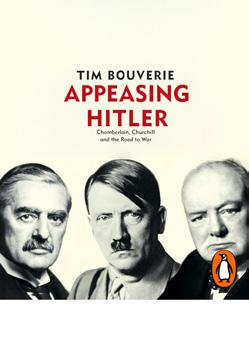
Chamberlain, Churchill and the road to war

Tim Bouverie

Monday 16 October 2023
Refreshments 4pm
Lecture 4:30pm - 5:30pm
ACADEMIC LECTURE SERIES
Lecture Theatre









 Patrick Stewart as Claudius in Gregory Dornan’s 2008 RSC production of Hamlet © Ellie Kurttz @ RSC
Patrick Stewart as Claudius in Gregory Dornan’s 2008 RSC production of Hamlet © Ellie Kurttz @ RSC






 Josh Rowley (A Level)
Lucia Martin (A Level)
Josh Rowley (A Level)
Lucia Martin (A Level)





 Charlie Angel (A Level)
Natalia Schmitt (A Level)
Charlie Angel (A Level)
Natalia Schmitt (A Level)


 Chrissie Holligon (A Level)
Sophie Knowles (A Level)
Chrissie Holligon (A Level)
Sophie Knowles (A Level)





 ‘Future leadership of the Afghan airforce’ Burke & Norfolk
‘Future leadership of the Afghan airforce’ Burke & Norfolk















 Brian Korteling
Brian Korteling

 John Singer Sargent
John Singer Sargent




 Elise Millington: Working from Home (GCSE)
Tom Keohane: Food and Drink (A Level)
Robert Lewis: Expedition first aid (A Level)
Elise Millington: Working from Home (GCSE)
Tom Keohane: Food and Drink (A Level)
Robert Lewis: Expedition first aid (A Level)





 Annabel Hewett: Working from home (GCSE)
Lara Toye: Inclusive Kitchen Aid (A Level)
Tom Steer: Coffee storage table (A Level)
Josh Done: Alfresco dining (A Level)
Frankie Powell: TV and Media unit (A Level)
Annabel Hewett: Working from home (GCSE)
Lara Toye: Inclusive Kitchen Aid (A Level)
Tom Steer: Coffee storage table (A Level)
Josh Done: Alfresco dining (A Level)
Frankie Powell: TV and Media unit (A Level)





 The January 6th insurrection
President Biden on the campaign trail
Zelenskyy’s character, Paddington Bear
The January 6th insurrection
President Biden on the campaign trail
Zelenskyy’s character, Paddington Bear



 The Domains by Antony Gormley
Louise by Birte Bosse
The Domains by Antony Gormley
Louise by Birte Bosse


 untitled by Jose Resende
And Tell Him Of My Pain by Sheela Gowda
untitled by Jose Resende
And Tell Him Of My Pain by Sheela Gowda















